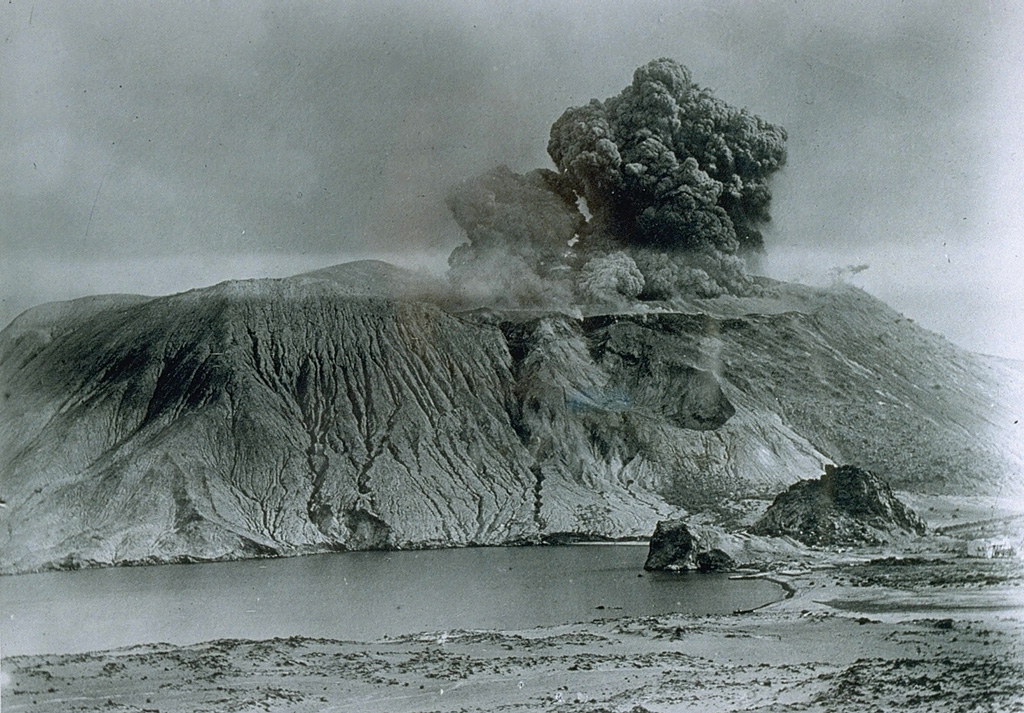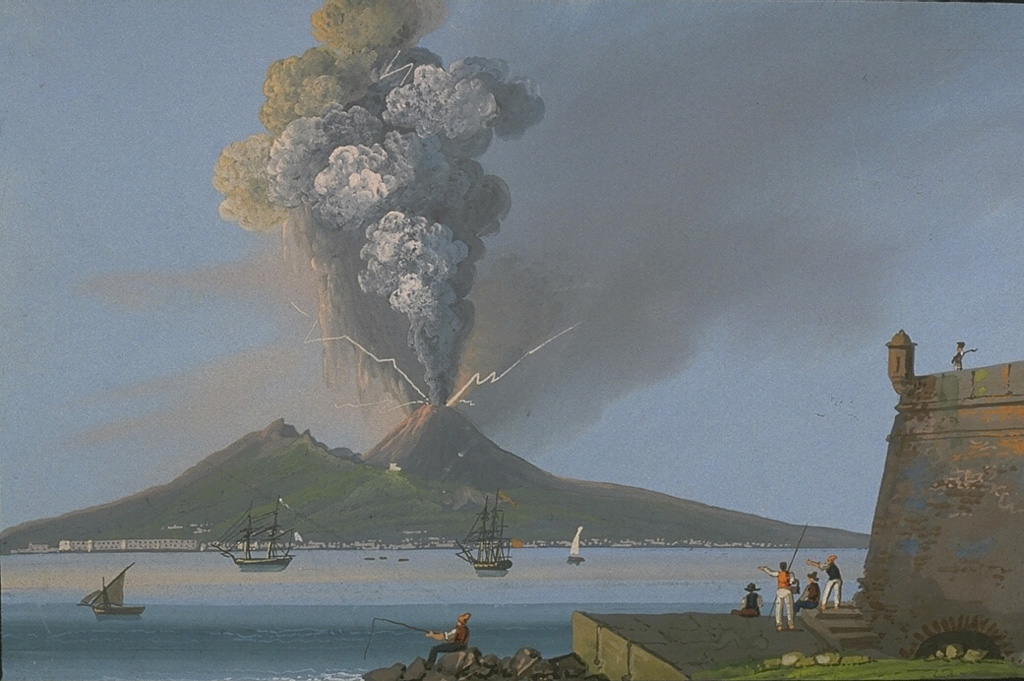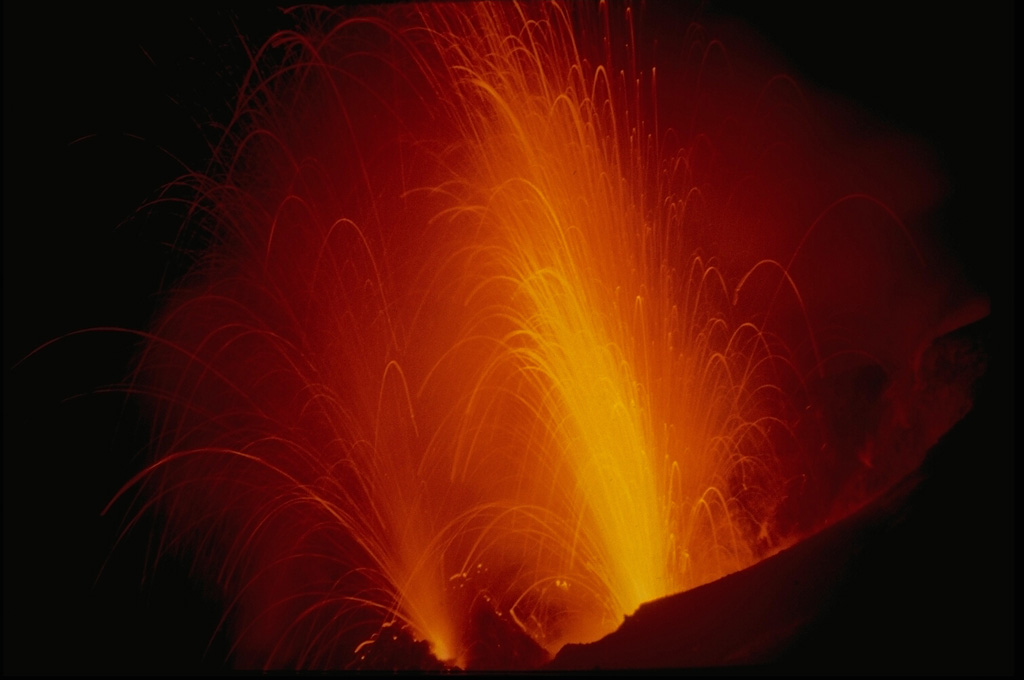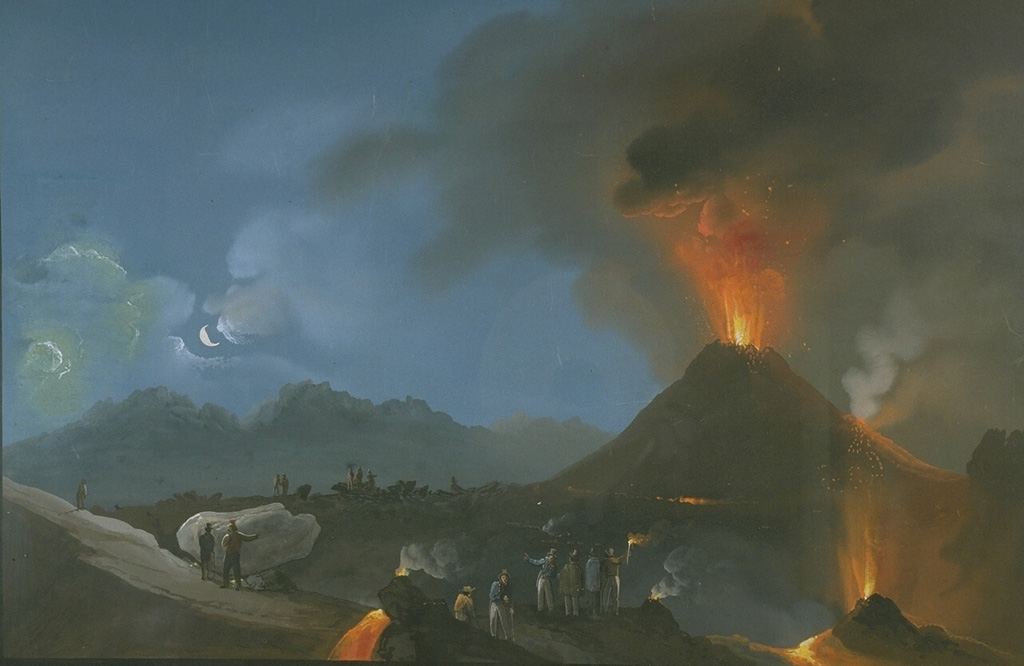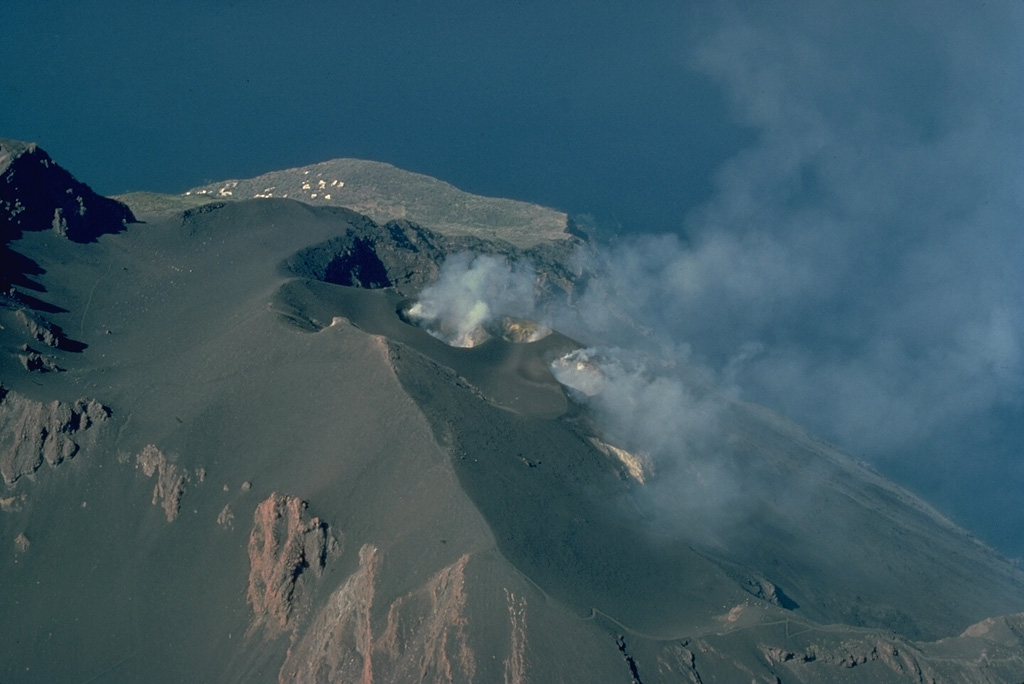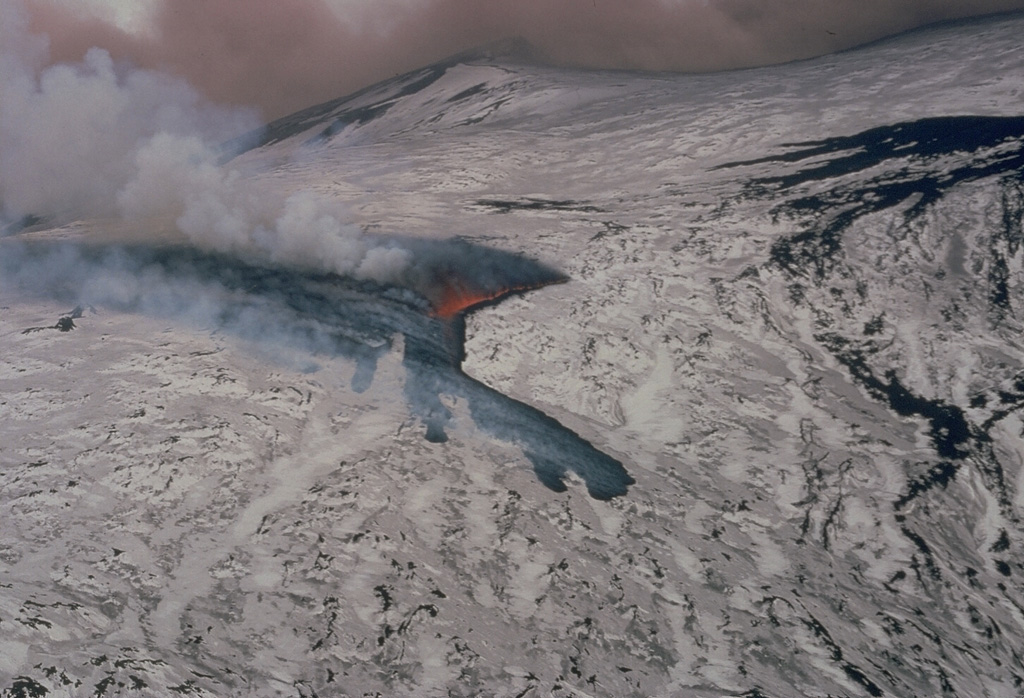Italy Volcanoes
Italy has 13 Holocene volcanoes. Note that as a scientific organization we provide these listings for informational purposes only, with no international legal or policy implications. Volcanoes will be included on this list if they are within the boundaries of a country, on a shared boundary or area, in a remote territory, or within a maritime Exclusive Economic Zone. Bolded volcanoes have erupted within the past 20 years. Suggestions and data updates are always welcome ().
| Volcano Name | Last Eruption | Volcanic Province | Primary Landform |
|---|---|---|---|
| Campi Flegrei | 1538 CE | Italian Peninsula Volcanic Provinces | Caldera |
| Campi Flegrei del Mar di Sicilia | 1867 CE | Sicily Volcanic Province | Cluster |
| Colli Albani | Unknown - Evidence Uncertain | Italian Peninsula Volcanic Provinces | Caldera |
| Etna | 2024 CE | Sicily Volcanic Province | Composite |
| Ischia | 1302 CE | Italian Peninsula Volcanic Provinces | Composite |
| Lipari | 1230 CE | Aeolian Volcanic Arc | Composite |
| Marsili | 1050 BCE | Aeolian Volcanic Arc | Composite |
| Palinuro | 8040 BCE | Aeolian Volcanic Arc | Composite |
| Panarea | Unknown - Evidence Uncertain | Aeolian Volcanic Arc | Composite |
| Pantelleria | 1891 CE | Sicily Volcanic Province | Shield |
| Stromboli | 2024 CE | Aeolian Volcanic Arc | Composite |
| Vesuvius | 1944 CE | Italian Peninsula Volcanic Provinces | Composite |
| Vulcano | 1890 CE | Aeolian Volcanic Arc | Composite |
Chronological listing of known Holocene eruptions (confirmed or uncertain) from volcanoes in Italy. Bolded eruptions indicate continuing activity.
| Volcano Name | Start Date | Stop Date | Certainty | VEI | Evidence |
|---|---|---|---|---|---|
| Etna | 2022 Nov 27 | 2024 Oct 17 (continuing) | Confirmed | 2 | Observations: Reported |
| Etna | 2013 Sep 3 | 2022 Jun 17 | Confirmed | 3 | Observations: Reported |
| Etna | 2010 Aug 25 | 2013 Apr 27 | Confirmed | 3 | Observations: Reported |
| Etna | 2010 Apr 8 | 2010 Apr 8 | Confirmed | 1 | Observations: Reported |
| Etna | 2007 Mar 19 | 2009 Jul 4 | Confirmed | 2 | Observations: Reported |
| Etna | 2006 Jul 14 | 2006 Dec 15 | Confirmed | 2 | Observations: Reported |
| Etna | 2005 Dec 16 | 2005 Dec 22 | Confirmed | 1 | Observations: Reported |
| Etna | 2004 Sep 7 | 2005 Mar 8 | Confirmed | 1 | Observations: Reported |
| Etna | 2004 Feb 12 | 2004 Feb 14 | Confirmed | 1 | Observations: Reported |
| Etna | 2001 Dec 16 (?) ± 15 days | 2003 Nov 9 | Confirmed | 3 | Observations: Reported |
| Etna | 1994 Jun 17 | 2001 Aug 9 | Confirmed | 3 | Observations: Reported |
| Etna | 1993 Aug 3 | 1993 Oct 13 | Confirmed | 1 | Observations: Reported |
| Etna | 1979 Jul 3 | 1993 Mar 30 | Confirmed | 3 | Observations: Reported |
| Etna | 1971 Sep 19 | 1979 Mar 16 (?) ± 15 days | Confirmed | 2 | Observations: Reported |
| Etna | 1966 Jan 10 | 1971 Jun 12 | Confirmed | 2 | Observations: Reported |
| Etna | 1959 Oct 17 | 1964 Dec 31 | Confirmed | 3 | Observations: Reported |
| Etna | 1959 Mar 23 | 1959 Apr 25 ± 5 days | Confirmed | 1 | Observations: Reported |
| Etna | 1958 Nov 16 ± 15 days | 1958 Dec 16 ± 15 days | Confirmed | 1 | Observations: Reported |
| Etna | 1957 Aug 25 | 1958 May 3 | Confirmed | 2 | Observations: Reported |
| Etna | 1957 Feb 5 | 1957 May 7 | Confirmed | 2 | Observations: Reported |
| Etna | 1955 Apr 5 | 1956 Apr 7 | Confirmed | 2 | Observations: Reported |
| Etna | [1953 Jul 30] | [Unknown] | Uncertain | ||
| Etna | 1949 Dec 2 | 1952 May 30 | Confirmed | 2 | Observations: Reported |
| Etna | 1947 Jan 29 | 1947 Mar 10 | Confirmed | 3 | Observations: Reported |
| Etna | 1946 Feb | 1946 Oct | Confirmed | 1 | Observations: Reported |
| Etna | 1945 Jun 5 ± 4 days | 1945 Oct | Confirmed | 1 | Observations: Reported |
| Etna | 1941 Oct (?) | 1944 Apr 26 ± 4 days | Confirmed | 2 | Observations: Reported |
| Etna | 1935 Jul 7 | 1941 Jan 27 (?) | Confirmed | 3 | Observations: Reported |
| Stromboli | 1934 Feb 2 | 2024 Oct 17 (continuing) | Confirmed | 2 | Observations: Reported |
| Etna | 1934 Jan 5 | 1934 Mar | Confirmed | 1 | Observations: Reported |
| Stromboli | 1932 Jun 3 | 1932 Jun 3 | Confirmed | 2 | Observations: Reported |
| Etna | 1931 Jul 26 ± 5 days | 1933 Sep | Confirmed | 2 | Observations: Reported |
| Etna | 1930 Nov 1 | Unknown | Confirmed | 1 | Observations: Reported |
| Etna | 1929 Aug 2 | Unknown | Confirmed | 1 | Observations: Reported |
| Etna | 1928 Jul 31 | 1928 Nov 20 | Confirmed | 1 | Observations: Reported |
| Etna | 1926 Jan 2 | 1926 Jun | Confirmed | 1 | Observations: Reported |
| Etna | 1919 Mar 15 | 1925 Feb | Confirmed | 2 | Observations: Reported |
| Etna | 1918 Mar | 1918 Dec 1 (?) | Confirmed | 2 | Observations: Reported |
| Etna | 1917 Jun 24 | 1917 Jul 5 ± 4 days | Confirmed | 2 | Observations: Reported |
| Etna | 1913 Nov 13 | 1917 Mar | Confirmed | 2 | Observations: Reported |
| Vesuvius | 1913 Jul 5 | 1944 Apr 4 | Confirmed | 3 | Observations: Reported |
| Etna | 1912 Aug 4 | 1912 Aug | Confirmed | 3 | Observations: Reported |
| Campi Flegrei del Mar di Sicilia | [1911 Sep 30] | [Unknown] | Uncertain | ||
| Etna | 1911 Aug | 1911 Sep 26 ± 4 days | Confirmed | 2 | Observations: Reported |
| Etna | 1910 Dec 27 | 1911 Feb 17 | Confirmed | 2 | Observations: Reported |
| Stromboli | 1910 May | 1931 Jul | Confirmed | 3 | Observations: Reported |
| Etna | 1910 Feb 21 | 1910 Apr 18 | Confirmed | 2 | Observations: Reported |
| Etna | 1908 Apr 29 | 1909 Sep 28 | Confirmed | 2 | Observations: Reported |
| Etna | 1899 Nov 15 | 1907 Aug | Confirmed | 2 | Observations: Reported |
| Etna | 1899 Jul 19 | 1899 Aug 5 | Confirmed | 3 | Observations: Reported |
| Etna | 1893 Apr 26 | 1898 Jun | Confirmed | 1 | Observations: Reported |
| Vulcano | [1892 Dec 14] | [Unknown] | Uncertain | ||
| Etna | 1892 Jun 20 | 1892 Dec 29 | Confirmed | 2 | Observations: Reported |
| Pantelleria | [1891 Dec] | [Unknown] | Uncertain | ||
| Pantelleria | 1891 Oct 17 | 1891 Oct 25 | Confirmed | 1 | Observations: Reported |
| Etna | 1891 Feb 20 | 1891 Dec | Confirmed | 2 | Observations: Reported |
| Etna | 1890 May | 1890 Oct 17 (?) | Confirmed | 2 | Observations: Reported |
| Stromboli | 1890 | 1907 May 29 | Confirmed | 3 | Observations: Reported |
| Vulcano | 1888 Aug 2 | 1890 Mar 22 | Confirmed | 3 | Observations: Reported |
| Etna | 1888 Apr 13 (in or before) | 1889 Aug | Confirmed | 2 | Observations: Reported |
| Etna | 1887 May 31 | 1887 Aug | Confirmed | 1 | Observations: Reported |
| Vulcano | 1886 Jan 5 ± 4 days | Unknown | Confirmed | 3 | Observations: Reported |
| Etna | 1884 | 1886 Jun 7 | Confirmed | 3 | Observations: Reported |
| Etna | 1878 Dec 23 | 1883 Mar 31 (in or after) | Confirmed | 3 | Observations: Reported |
| Vesuvius | 1875 Dec 18 | 1906 Apr 22 | Confirmed | 4 | Observations: Reported |
| Etna | 1874 Aug 29 | 1874 Aug 31 | Confirmed | 2 | Observations: Reported |
| Etna | 1874 May | Unknown | Confirmed | 2 | Observations: Reported |
| Vesuvius | [1874 Jan] | [Unknown] | Uncertain | ||
| Vulcano | 1873 Sep | 1879 | Confirmed | 3 | Observations: Reported |
| Vesuvius | 1870 Dec | 1872 Apr 30 | Confirmed | 3 | Observations: Reported |
| Etna | 1869 Sep 26 | 1869 Sep 26 | Confirmed | 0 | Observations: Reported |
| Etna | 1868 Nov 26 (?) | 1868 Dec 8 | Confirmed | 3 | Observations: Reported |
| Campi Flegrei del Mar di Sicilia | 1867 | Unknown | Confirmed | 0 | Observations: Reported |
| Etna | 1865 Jan 30 | 1865 Jun 28 | Confirmed | 2 | Observations: Reported |
| Etna | 1864 Aug 5 ± 4 days | 1864 Sep 19 | Confirmed | 2 | Observations: Reported |
| Vesuvius | 1864 Feb 10 | 1868 Nov 26 | Confirmed | 2 | Observations: Reported |
| Campi Flegrei del Mar di Sicilia | 1863 Aug 12 | Unknown | Confirmed | 2 | Observations: Reported |
| Etna | 1863 May 1 | 1863 Jul 25 (?) | Confirmed | 3 | Observations: Reported |
| Etna | [1857 Sep 6] | [Unknown] | Uncertain | ||
| Stromboli | 1857 | 1889 Jun 26 | Confirmed | 3 | Observations: Reported |
| Vesuvius | 1855 Dec 19 | 1861 Dec 31 | Confirmed | 3 | Observations: Reported |
| Vesuvius | 1854 Dec 14 | 1855 May 27 | Confirmed | 3 | Observations: Reported |
| Etna | 1852 Aug 20 | 1853 May 27 | Confirmed | 2 | Observations: Reported |
| Campi Flegrei del Mar di Sicilia | 1846 Oct 4 | 1846 Oct 5 | Confirmed | 2 | Observations: Reported |
| Etna | 1843 Nov 17 | 1843 Dec 16 (?) | Confirmed | 2 | Observations: Reported |
| Etna | 1842 Nov 18 | 1842 Dec 29 (?) | Confirmed | 2 | Observations: Reported |
| Vesuvius | 1841 Sep 20 | 1850 Feb 16 | Confirmed | 2 | Observations: Reported |
| Etna | 1838 Jul 8 | 1839 Feb | Confirmed | 2 | Observations: Reported |
| Vesuvius | 1835 Jan | 1839 Jan 3 | Confirmed | 3 | Observations: Reported |
| Etna | 1832 Oct 31 | 1832 Nov 22 | Confirmed | 2 | Observations: Reported |
| Campi Flegrei del Mar di Sicilia | 1831 Jun 28 (in or after) | 1831 Aug 11 ± 4 days | Confirmed | 3 | Observations: Reported |
| Pantelleria | [1831] | [Unknown] | Uncertain | ||
| Vulcano | [1831] | [Unknown] | Uncertain | ||
| Vesuvius | 1824 Jul 2 | 1834 Sep 2 | Confirmed | 3 | Observations: Reported |
| Vulcano | [1822] | [1823] | Uncertain | ||
| Etna | 1820 Dec (?) | 1833 | Confirmed | 2 | Observations: Reported |
| Etna | 1819 May 27 | 1819 Aug 5 | Confirmed | 2 | Observations: Reported |
| Etna | [1816 Mar 6] | [Unknown] | Uncertain | ||
| Vulcano | [1812] | [Unknown] | Uncertain | ||
| Etna | 1811 Oct 27 | 1812 May (?) | Confirmed | 2 | Observations: Reported |
| Etna | 1809 Mar 27 | 1809 Apr 9 | Confirmed | 2 | Observations: Reported |
| Etna | 1803 Jan 1 | 1819 (?) | Confirmed | 2 | Observations: Reported |
| Etna | 1802 Nov 15 | 1802 Nov 18 | Confirmed | 2 | Observations: Reported |
| Vesuvius | 1796 Jan | 1822 Nov 16 | Confirmed | 3 | Observations: Reported |
| Etna | 1793 (?) | 1802 (?) | Confirmed | 3 | Observations: Reported |
| Etna | 1792 Mar | 1793 May 26 ± 5 days | Confirmed | 3 | Observations: Reported |
| Etna | 1791 Feb | 1791 Sep | Confirmed | 2 | Observations: Reported |
| Etna | 1787 Jun 4 ± 4 days | 1787 Aug 11 | Confirmed | 4 | Observations: Reported |
| Vulcano | [1786] | [Unknown] | Uncertain | ||
| Vesuvius | 1783 Aug 18 | 1794 Jul 5 | Confirmed | 3 | Observations: Reported |
| Etna | 1781 Mar | 1781 May 10 | Confirmed | 2 | Observations: Reported |
| Etna | 1780 Apr 20 (?) | 1780 Jul (?) | Confirmed | 2 | Observations: Reported |
| Vulcano | 1780 | Unknown | Confirmed | 2 | Observations: Reported |
| Etna | 1776 | Unknown | Confirmed | Observations: Reported | |
| Vulcano | [1775] | [Unknown] | Uncertain | ||
| Vulcano | 1771 Feb 17 | 1771 May | Confirmed | 3 | Observations: Reported |
| Etna | [1770 May 28 ± 1 days] | [Unknown] | Uncertain | ||
| Vesuvius | 1770 Feb 15 | 1779 Oct 4 (?) | Confirmed | 3 | Observations: Reported |
| Etna | 1767 May 2 | Unknown | Confirmed | Observations: Reported | |
| Etna | 1766 Apr 27 | 1766 Nov 6 | Confirmed | 2 | Observations: Reported |
| Vesuvius | 1764 | 1767 Oct 27 | Confirmed | 3 | Observations: Reported |
| Vesuvius | 1744 Nov (?) | 1761 Jan 6 | Confirmed | 3 | Observations: Reported |
| Vesuvius | 1742 | 1743 | Confirmed | 1 | Observations: Reported |
| Vesuvius | 1732 Dec 25 | 1737 Jun 4 | Confirmed | 3 | Observations: Reported |
| Etna | 1732 Dec 9 | 1765 | Confirmed | 3 | Observations: Reported |
| Vulcano | 1731 | 1739 | Confirmed | 3 | Observations: Reported |
| Etna | 1727 Nov 22 | 1728 May 10 (?) | Confirmed | 2 | Observations: Reported |
| Vulcano | 1727 | Unknown | Confirmed | 3 | Observations: Reported |
| Vesuvius | 1724 Sep 4 | 1730 Apr 1 (?) | Confirmed | 3 | Observations: Reported |
| Etna | [1723 Nov 22] | [1724 May (?)] | Uncertain | ||
| Vesuvius | 1708 Aug 14 | 1723 Jul 8 | Confirmed | 3 | Observations: Reported |
| Etna | 1702 Mar 8 | 1702 May 8 | Confirmed | 1 | Observations: Reported |
| Vesuvius | 1701 Jul 1 | 1707 Aug 22 | Confirmed | 3 | Observations: Reported |
| Campi Flegrei del Mar di Sicilia | [1701] | [Unknown] | Uncertain | ||
| Vesuvius | 1697 Sep 15 | 1698 Jul | Confirmed | 3 | Observations: Reported |
| Vesuvius | 1696 Jul 31 | 1696 Aug 14 (?) | Confirmed | 2 | Observations: Reported |
| Etna | 1693 Dec | 1694 Nov (?) | Confirmed | 3 | Observations: Reported |
| Etna | [1693 Jan 9] | [Unknown] | Uncertain | ||
| Etna | 1689 Mar 14 | Unknown | Confirmed | 1 | Observations: Reported |
| Etna | 1688 | Unknown | Confirmed | 1 | Observations: Reported |
| Vulcano | 1688 | Unknown | Confirmed | Observations: Reported | |
| Vesuvius | 1685 Oct 3 | 1694 Apr 29 | Confirmed | 3 | Observations: Reported |
| Etna | 1682 Sep 1 | 1682 Oct (?) | Confirmed | 2 | Observations: Reported |
| Vesuvius | 1682 Aug 12 | 1682 Aug 22 | Confirmed | 3 | Observations: Reported |
| Etna | 1669 Mar 11 | 1669 Jul 11 (?) | Confirmed | 3 | Observations: Reported |
| Vesuvius | 1654 Feb 25 | 1680 Mar 28 | Confirmed | 3 | Observations: Reported |
| Etna | 1654 Jan 1 | 1656 (?) | Confirmed | 1 | Observations: Reported |
| Etna | 1651 Jan 17 | 1653 Jul (?) | Confirmed | 1 | Observations: Reported |
| Vulcano | 1651 | Unknown | Confirmed | Observations: Reported | |
| Etna | 1646 Nov 20 | 1647 Jan 17 | Confirmed | 2 | Observations: Reported |
| Etna | 1643 Feb 20 | 1643 Feb 28 | Confirmed | 1 | Observations: Reported |
| Vesuvius | 1637 Jul 1 | 1652 Dec | Confirmed | 2 | Observations: Reported |
| Etna | 1634 Dec 19 (?) | 1638 Apr 27 | Confirmed | 1 | Observations: Reported |
| Etna | [1633 Feb 21] | [Unknown] | Uncertain | ||
| Campi Flegrei del Mar di Sicilia | 1632 | Unknown | Confirmed | 0 | Observations: Reported |
| Vesuvius | 1631 Dec 16 | 1632 Jan 31 (?) | Confirmed | 5 | Observations: Reported |
| Vulcano | 1631 | Unknown | Confirmed | Observations: Reported | |
| Vulcano | 1626 Mar | 1626 Apr | Confirmed | 3 | Observations: Reported |
| Vulcano | 1618 | Unknown | Confirmed | Observations: Reported | |
| Etna | 1614 Jul 1 (?) | 1624 | Confirmed | 2 | Observations: Reported |
| Etna | 1610 Feb 6 | 1610 Aug 15 | Confirmed | 2 | Observations: Reported |
| Etna | 1607 Jun 28 | 1608 (?) | Confirmed | 2 | Observations: Reported |
| Etna | 1603 Jul | 1610 | Confirmed | 2 | Observations: Reported |
| Etna | 1579 Sep 9 (?) | 1580 (?) | Confirmed | Observations: Reported | |
| Etna | [1578] | [Unknown] | Uncertain | ||
| Vesuvius | 1570 (in or before) | 1572 ± 1 years | Confirmed | 1 | Observations: Reported |
| Etna | 1566 Nov 1 (?) | 1566 Dec | Confirmed | 2 | Observations: Reported |
| Stromboli | 1558 (in or before) | 1857 | Confirmed | 3 | Observations: Reported |
| Etna | [1554] | [Unknown] | Uncertain | ||
| Vulcano | 1550 | Unknown | Confirmed | 3 | Observations: Reported |
| Etna | 1541 Jul (?) | Unknown | Confirmed | 2 | Observations: Reported |
| Etna | 1540 Jul | Unknown | Confirmed | 1 | Observations: Reported |
| Campi Flegrei | 1538 Sep 29 | 1538 Oct 6 | Confirmed | 3 | Observations: Reported |
| Etna | 1537 Mar (?) | 1537 Jul | Confirmed | 2 | Observations: Reported |
| Etna | 1536 Mar 22 | 1536 Dec (?) | Confirmed | 3 | Observations: Reported |
| Vesuvius | 1500 | Unknown | Confirmed | 2 | Observations: Reported |
| Etna | 1493 (?) | 1500 (?) | Confirmed | 1 | Observations: Reported |
| Etna | 1447 Sep 21 | Unknown | Confirmed | 1 | Observations: Reported |
| Etna | 1446 Sep 25 | Unknown | Confirmed | 1 | Observations: Reported |
| Vulcano | 1444 Feb 4 | Unknown | Confirmed | 3 | Observations: Reported |
| Etna | 1444 | Unknown | Confirmed | 2 | Observations: Reported |
| Etna | 1408 Nov 8 | 1408 Nov 25 (?) | Confirmed | 3 | Observations: Reported |
| Etna | 1381 Aug 6 (?) (?) | Unknown | Confirmed | 2 | Observations: Reported |
| Etna | 1350 | Unknown | Confirmed | 2 | Observations: Reported |
| Vesuvius | [1347] | [Unknown] | Uncertain | ||
| Etna | 1333 | Unknown | Confirmed | 2 | Observations: Reported |
| Etna | 1329 Jun 28 | 1329 Aug 4 ± 4 days | Confirmed | 3 | Observations: Reported |
| Ischia | 1302 Jan 18 | 1302 Mar | Confirmed | Observations: Reported | |
| Ischia | 1290 (?) | Unknown | Confirmed | Isotopic: 14C (calibrated) | |
| Etna | 1284 | 1285 Jan (?) | Confirmed | Observations: Reported | |
| Vesuvius | [1270] | [Unknown] | Uncertain | ||
| Etna | 1250 | Unknown | Confirmed | 2 | Observations: Reported |
| Lipari | 1230 ± 40 years | Unknown | Confirmed | Correlation: Magnetism | |
| Vulcano | 1230 ± 20 years | Unknown | Confirmed | 0 | Correlation: Magnetism |
| Etna | 1224 Aug (?) | Unknown | Confirmed | Observations: Reported | |
| Vulcano | 1200 ± 75 years | Unknown | Confirmed | 2 | Correlation: Magnetism |
| Campi Flegrei | 1198 | Unknown | Confirmed | 1 | Observations: Reported |
| Etna | 1194 | Unknown | Confirmed | 2 | Observations: Reported |
| Etna | [1169 Feb 4] | [Unknown] | Uncertain | ||
| Etna | 1164 (?) | Unknown | Confirmed | 2 | Observations: Reported |
| Etna | 1160 | Unknown | Confirmed | 2 | Observations: Reported |
| Etna | 1157 | Unknown | Confirmed | 2 | Observations: Reported |
| Vesuvius | 1150 | Unknown | Confirmed | 3 | Observations: Reported |
| Vesuvius | 1139 Jun 1 | 1139 Jun 9 | Confirmed | 3 | Observations: Reported |
| Vesuvius | [1073 ± 5 years] | [Unknown] | Uncertain | ||
| Etna | 1063 ± 1 years | Unknown | Confirmed | Observations: Reported | |
| Vesuvius | [1049] | [Unknown] | Uncertain | ||
| Etna | [1044] | [Unknown] | Uncertain | ||
| Vulcano | 1040 ± 75 years | Unknown | Confirmed | 2 | Correlation: Magnetism |
| Vesuvius | 1037 Jan 27 | Unknown | Confirmed | 3 | Observations: Reported |
| Vesuvius | 1006 Dec 31 ± 365 days | Unknown | Confirmed | 3 | Observations: Reported |
| Etna | [1004] | [Unknown] | Uncertain | ||
| Vesuvius | 0999 | Unknown | Confirmed | 3 | Observations: Reported |
| Vesuvius | 0991 | Unknown | Confirmed | 3 | Observations: Reported |
| Vesuvius | 0968 Dec 1 ± 30 days | Unknown | Confirmed | 4 | Observations: Reported |
| Stromboli | 0950 ± 50 years | Unknown | Confirmed | 2 | Observations: Reported |
| Vulcano | 0925 ± 25 years | Unknown | Confirmed | 3 | Observations: Reported |
| Etna | [0911] | [Unknown] | Uncertain | ||
| Vesuvius | 0900 ± 40 years | Unknown | Confirmed | 0 | Correlation: Magnetism |
| Vesuvius | 0860 ± 50 years | Unknown | Confirmed | 0 | Correlation: Magnetism |
| Etna | [0859] | [Unknown] | Uncertain | ||
| Ischia | 0820 ± 300 years | Unknown | Confirmed | Isotopic: 14C (calibrated) | |
| Etna | [0814] | [Unknown] | Uncertain | ||
| Etna | [0812 (?)] | [Unknown] | Uncertain | ||
| Vesuvius | 0787 Oct 15 ± 45 days | 0788 Jan 15 ± 45 days | Confirmed | 3 | Observations: Reported |
| Lipari | 0780 ± 100 years | Unknown | Confirmed | Isotopic: 14C (calibrated) | |
| Vulcano | 0729 | Unknown | Confirmed | Observations: Reported | |
| Vesuvius | 0685 Feb | 0685 Mar | Confirmed | 4 | Observations: Reported |
| Etna | [0644] | [Unknown] | Uncertain | ||
| Stromboli | 0550 ± 50 years | Unknown | Confirmed | 3 | Observations: Reported |
| Ischia | 0540 ± 150 years | Unknown | Confirmed | Isotopic: 14C (calibrated) | |
| Vesuvius | 0536 | Unknown | Confirmed | Observations: Reported | |
| Vulcano | 0526 (?) | Unknown | Confirmed | 3 | Observations: Reported |
| Vesuvius | 0512 Jul 8 | Unknown | Confirmed | 4 | Observations: Reported |
| Vesuvius | [0505 Nov 9] | [Unknown] | Uncertain | ||
| Vesuvius | 0472 Nov 5 | 0472 Nov 6 (?) | Confirmed | 5 | Observations: Reported |
| Etna | 0417 (?) | Unknown | Confirmed | Observations: Reported | |
| Vesuvius | 0379 | 0395 | Confirmed | 2 | Observations: Reported |
| Vesuvius | [0303] | [Unknown] | Uncertain | ||
| Ischia | 0295 ± 10 years | Unknown | Confirmed | Observations: Reported | |
| Etna | 0252 Feb 1 | 0252 Feb 9 | Confirmed | 3 | Observations: Reported |
| Stromboli | 0250 ± 50 years | Unknown | Confirmed | 2 | Observations: Reported |
| Vesuvius | 0222 | 0235 | Confirmed | 2 | Observations: Reported |
| Vesuvius | 0203 | Unknown | Confirmed | 4 | Observations: Reported |
| Vesuvius | 0172 | Unknown | Confirmed | 3 | Observations: Reported |
| Stromboli | 0150 ± 50 years | Unknown | Confirmed | 2 | Observations: Reported |
| Ischia | 0145 (?) | Unknown | Confirmed | Observations: Reported | |
| Vulcano | 0144 | Unknown | Confirmed | Observations: Reported | |
| Etna | 0100 ± 100 years | Unknown | Confirmed | Correlation: Tephrochronology | |
| Etna | [0080 (?)] | [Unknown] | Uncertain | ||
| Ischia | 0080 ± 1 years | Unknown | Confirmed | Observations: Reported | |
| Vesuvius | 0079 Oct 24 (?) | 0079 Oct 28 ± 1 days | Confirmed | 5 | Observations: Reported |
| Ischia | [0069] | [Unknown] | Uncertain | ||
| Vulcano | 0050 ± 50 years | Unknown | Confirmed | Observations: Reported | |
| Stromboli | 0050 ± 50 years | Unknown | Confirmed | 2 | Observations: Reported |
| Ischia | 0040 ± 75 years | Unknown | Confirmed | 3 | Isotopic: 14C (calibrated) |
| Etna | 0039 ± 1 years | Unknown | Confirmed | Observations: Reported | |
| Etna | 0010 (?) | 0020 (?) | Confirmed | Observations: Reported | |
| Ischia | 0006 BCE ± 20 years | Unknown | Confirmed | Observations: Reported | |
| Etna | [0010 BCE (?)] | [Unknown] | Uncertain | ||
| Vulcano | [0010 BCE ± 10 years] | [Unknown] | Uncertain | ||
| Vulcano | 0024 BCE ± 5 years | Unknown | Confirmed | Observations: Reported | |
| Etna | 0032 Dec 31 BCE ± 365 days | Unknown | Confirmed | Observations: Reported | |
| Etna | 0036 Jul 15 BCE ± 45 days | 0035 BCE | Confirmed | Observations: Reported | |
| Etna | 0044 Mar BCE (?) | Unknown | Confirmed | 3 | Observations: Reported |
| Etna | 0049 BCE | Unknown | Confirmed | Observations: Reported | |
| Stromboli | 0050 BCE ± 50 years | Unknown | Confirmed | 2 | Observations: Reported |
| Etna | [0056 BCE] | [Unknown] | Uncertain | ||
| Etna | [0061 BCE] | [Unknown] | Uncertain | ||
| Vulcano | 0091 BCE | Unknown | Confirmed | 3 | Observations: Reported |
| Ischia | 0091 BCE | Unknown | Confirmed | Observations: Reported | |
| Vulsini | [0104 BCE] | [Unknown] | Uncertain | ||
| Etna | 0122 BCE | Unknown | Confirmed | 5 | Observations: Reported |
| Etna | 0126 Jun BCE (in or before) | Unknown | Confirmed | Observations: Reported | |
| Vulcano | 0126 Jun BCE | Unknown | Confirmed | Observations: Reported | |
| Etna | 0135 BCE | Unknown | Confirmed | Observations: Reported | |
| Etna | 0141 Dec 31 BCE ± 365 days | Unknown | Confirmed | Observations: Reported | |
| Vulcano | 0150 BCE ± 300 years | Unknown | Confirmed | Isotopic: Uranium-series | |
| Vulcano | 0183 BCE | Unknown | Confirmed | 4 | Observations: Reported |
| Ischia | 0200 BCE ± 200 years | Unknown | Confirmed | Correlation: Magnetism | |
| Stromboli | 0210 BCE ± 10 years | Unknown | Confirmed | 2 | Observations: Reported |
| Vulcano | 0215 BCE | Unknown | Confirmed | Observations: Reported | |
| Vesuvius | 0217 BCE | 0216 BCE | Confirmed | 3 | Observations: Reported |
| Campi Flegrei del Mar di Sicilia | 0253 BCE ± 12 years | Unknown | Confirmed | Observations: Reported | |
| Vulcano | 0300 BCE | Unknown | Confirmed | 2 | Observations: Reported |
| Stromboli | 0350 BCE ± 50 years | Unknown | Confirmed | 2 | Observations: Reported |
| Vulcano | 0360 BCE ± 10 years | Unknown | Confirmed | 2 | Observations: Reported |
| Ischia | 0370 BCE ± 150 years | Unknown | Confirmed | Correlation: Magnetism | |
| Etna | 0396 Apr 15 BCE (?) ± 45 days | Unknown | Confirmed | Observations: Reported | |
| Etna | 0425 Mar 15 BCE ± 15 days | 0424 BCE (?) | Confirmed | Observations: Reported | |
| Ischia | 0470 BCE (?) | Unknown | Confirmed | Observations: Reported | |
| Vulcano | 0475 BCE (?) | Unknown | Confirmed | Observations: Reported | |
| Etna | 0479 Aug BCE (?) | 0475 BCE (?) | Confirmed | Observations: Reported | |
| Ischia | 0490 BCE ± 150 years | Unknown | Confirmed | Correlation: Magnetism | |
| Etna | [0565 BCE] | [Unknown] | Uncertain | ||
| Colli Albani | [0600 BCE] | [Unknown] | Uncertain | ||
| Vesuvius | 0600 BCE (in or before) | Unknown | Confirmed | 3 | Correlation: Anthropology |
| Etna | 0695 BCE ± 2 years | Unknown | Confirmed | Observations: Reported | |
| Ischia | 0700 BCE ± 75 years | Unknown | Confirmed | Correlation: Tephrochronology | |
| Etna | [0735 BCE] | [Unknown] | Uncertain | ||
| Vesuvius | 0880 BCE ± 50 years | Unknown | Confirmed | 4 | Isotopic: 14C (calibrated) |
| Ischia | 0930 BCE ± 150 years | Unknown | Confirmed | Isotopic: 14C (calibrated) | |
| Vulcano | 0950 BCE ± 500 years | Unknown | Confirmed | 0 | Isotopic: Uranium-series |
| Etna | 1050 BCE ± 75 years | Unknown | Confirmed | Isotopic: 14C (uncalibrated) | |
| Marsili | 1050 BCE ± 200 years | Unknown | Confirmed | Isotopic: 14C (calibrated) | |
| Pantelleria | 1080 BCE ± 300 years | Unknown | Confirmed | Isotopic: 14C (uncalibrated) | |
| Vulcano | 1300 BCE (?) | Unknown | Confirmed | 3 | Correlation: Tephrochronology |
| Etna | 1420 BCE ± 75 years | Unknown | Confirmed | Isotopic: 14C (calibrated) | |
| Vesuvius | 1430 BCE ± 300 years | Unknown | Confirmed | 4 | Isotopic: 14C (calibrated) |
| Ischia | 1480 BCE ± 300 years | Unknown | Confirmed | Correlation: Magnetism | |
| Etna | 1500 BCE ± 50 years | Unknown | Confirmed | 5 | Observations: Reported |
| Vesuvius | 1550 BCE ± 75 years | Unknown | Confirmed | 4 | Isotopic: 14C (calibrated) |
| Campi Flegrei | 1650 BCE (?) | Unknown | Confirmed | 4 | Correlation: Tephrochronology |
| Campi Flegrei | 1870 BCE ± 50 years | Unknown | Confirmed | 4 | Isotopic: 14C (uncalibrated) |
| Etna | 1980 BCE ± 50 years | Unknown | Confirmed | Isotopic: 14C (uncalibrated) | |
| Campi Flegrei | 2000 BCE ± 150 years | Unknown | Confirmed | 4 | Correlation: Tephrochronology |
| Campi Flegrei | 2040 BCE (?) | Unknown | Confirmed | 3 | Correlation: Tephrochronology |
| Campi Flegrei | 2080 BCE ± 75 years | Unknown | Confirmed | 2 | Correlation: Tephrochronology |
| Campi Flegrei | 2150 BCE ± 500 years | Unknown | Confirmed | 5 | Isotopic: 14C (uncalibrated) |
| Campi Flegrei | 2220 BCE ± 50 years | Unknown | Confirmed | Isotopic: 14C (uncalibrated) | |
| Campi Flegrei | 2330 BCE ± 150 years | Unknown | Confirmed | 3 | Correlation: Tephrochronology |
| Etna | 2330 BCE ± 100 years | Unknown | Confirmed | Isotopic: 14C (uncalibrated) | |
| Ischia | 2350 BCE ± 1400 years | Unknown | Confirmed | Isotopic: K/Ar | |
| Vesuvius | 2420 BCE ± 40 years | Unknown | Confirmed | 5 | Isotopic: 14C (calibrated) |
| Campi Flegrei | 2440 BCE (?) | Unknown | Confirmed | Isotopic: 14C (uncalibrated) | |
| Campi Flegrei | 2500 BCE (?) | Unknown | Confirmed | 4 | Correlation: Tephrochronology |
| Campi Flegrei | 2580 BCE ± 50 years | Unknown | Confirmed | Isotopic: 14C (uncalibrated) | |
| Vulcano | 2650 BCE ± 1700 years | Unknown | Confirmed | 3 | Isotopic: K/Ar |
| Ischia | 2700 BCE ± 1750 years | Unknown | Confirmed | Correlation: Tephrochronology | |
| Campi Flegrei | 2890 BCE ± 50 years | Unknown | Confirmed | Isotopic: 14C (uncalibrated) | |
| Ischia | 3050 BCE ± 1000 years | Unknown | Confirmed | Isotopic: K/Ar | |
| Etna | 3050 BCE ± 150 years | Unknown | Confirmed | Isotopic: 14C (uncalibrated) | |
| Marsili | 3050 BCE ± 200 years | Unknown | Confirmed | Correlation: Tephrochronology | |
| Etna | 3390 BCE ± 50 years | Unknown | Confirmed | Isotopic: 14C (uncalibrated) | |
| Etna | 3510 BCE ± 150 years | Unknown | Confirmed | Isotopic: 14C (uncalibrated) | |
| Vulcano | 3550 BCE ± 1300 years | Unknown | Confirmed | 0 | Isotopic: K/Ar |
| Ischia | 3580 BCE ± 300 years | Unknown | Confirmed | Isotopic: 14C (calibrated) | |
| Ischia | 3880 BCE ± 200 years | Unknown | Confirmed | Correlation: Magnetism | |
| Stromboli | 4050 BCE (?) | Unknown | Confirmed | 3 | Isotopic: 14C (uncalibrated) |
| Etna | 4150 BCE ± 150 years | Unknown | Confirmed | Isotopic: 14C (uncalibrated) | |
| Stromboli | 4250 BCE (?) | Unknown | Confirmed | 2 | Correlation: Magnetism |
| Pantelleria | 4430 BCE ± 200 years | Unknown | Confirmed | Isotopic: 14C (calibrated) | |
| Pantelleria | 4550 BCE ± 300 years | Unknown | Confirmed | Correlation: Magnetism | |
| Stromboli | 4550 BCE (?) | Unknown | Confirmed | 0 | Correlation: Magnetism |
| Stromboli | 4800 BCE ± 300 years | Unknown | Confirmed | 2 | Correlation: Magnetism |
| Stromboli | 5050 BCE (?) | Unknown | Confirmed | 0 | Correlation: Magnetism |
| Etna | 5150 BCE ± 150 years | Unknown | Confirmed | Isotopic: 14C (uncalibrated) | |
| Stromboli | 5550 BCE (?) | Unknown | Confirmed | 0 | Correlation: Magnetism |
| Pantelleria | 5610 BCE ± 100 years | Unknown | Confirmed | Isotopic: 14C (uncalibrated) | |
| Stromboli | 5800 BCE ± 300 years | Unknown | Confirmed | 0 | Correlation: Magnetism |
| Lipari | 5820 BCE ± 75 years | Unknown | Confirmed | Isotopic: 14C (calibrated) | |
| Stromboli | 6050 BCE (?) | Unknown | Confirmed | 0 | Correlation: Magnetism |
| Pantelleria | 6130 BCE ± 75 years | Unknown | Confirmed | Isotopic: 14C (uncalibrated) | |
| Etna | 6190 BCE ± 200 years | Unknown | Confirmed | Isotopic: 14C (uncalibrated) | |
| Campi Flegrei | 6300 BCE ± 50 years | Unknown | Confirmed | Isotopic: 14C (uncalibrated) | |
| Vulcano | 6350 BCE ± 1600 years | Unknown | Confirmed | Isotopic: K/Ar | |
| Campi Flegrei | 6490 BCE (?) | Unknown | Confirmed | 3 | Correlation: Tephrochronology |
| Vulcano | 6550 BCE (?) | Unknown | Confirmed | Isotopic: K/Ar | |
| Campi Flegrei | 6650 BCE ± 100 years | Unknown | Confirmed | 4 | Isotopic: 14C (uncalibrated) |
| Vesuvius | 6940 BCE ± 100 years | Unknown | Confirmed | 5 | Isotopic: 14C (calibrated) |
| Pantelleria | 7050 BCE (?) | Unknown | Confirmed | Isotopic: K/Ar | |
| Ischia | 7550 BCE ± 2400 years | Unknown | Confirmed | Isotopic: K/Ar | |
| Campi Flegrei | 7590 BCE ± 50 years | Unknown | Confirmed | Isotopic: 14C (uncalibrated) | |
| Campi Flegrei | 7980 BCE ± 500 years | Unknown | Confirmed | 3 | Correlation: Tephrochronology |
| Palinuro | 8040 BCE ± 100 years | Unknown | Confirmed | Isotopic: 14C (calibrated) | |
| Campi Flegrei | 8480 BCE ± 100 years | Unknown | Confirmed | 4 | Isotopic: 14C (calibrated) |
Italy has 24 Pleistocene volcanoes. Note that as a scientific organization we provide these listings for informational purposes only, with no international legal or policy implications. Volcanoes will be included on this list if they are within the boundaries of a country, on a shared boundary or area, in a remote territory, or within a maritime Exclusive Economic Zone. Suggestions and data updates are always welcome ().
| Volcano Name | Volcanic Province | Primary Volcano Type |
|---|---|---|
| Acquasparta | Italian Peninsula Volcanic Provinces | Cluster |
| Alicudi | Aeolian Volcanic Arc | Composite |
| Amiata | Italian Peninsula Volcanic Provinces | Minor |
| Cupaello | Italian Peninsula Volcanic Provinces | Minor |
| Monti Ernici | Italian Peninsula Volcanic Provinces | Cluster |
| Filicudi | Aeolian Volcanic Arc | Composite |
| Gaeta Bay Volcanic Field | Italian Peninsula Volcanic Provinces | Cluster |
| Iblei | Sicily Volcanic Province | Shield |
| Linosa | Sicily Volcanic Province | Minor |
| Logudoro | Western European Volcanic Province | Cluster |
| Oricola-Carsoli | Italian Peninsula Volcanic Provinces | Cluster |
| Polino | Italian Peninsula Volcanic Provinces | Minor |
| Pontine Islands | Italian Peninsula Volcanic Provinces | Minor |
| Radicofani | Italian Peninsula Volcanic Provinces | Minor |
| Roccamonfina | Italian Peninsula Volcanic Provinces | Composite |
| Sabatini Complex | Italian Peninsula Volcanic Provinces | Composite |
| Salina | Aeolian Volcanic Arc | Composite |
| San Venanzo | Italian Peninsula Volcanic Provinces | Minor |
| Torre Alfina | Italian Peninsula Volcanic Provinces | Minor |
| Ustica | Sicily Volcanic Province | Composite |
| Ventotene | Italian Peninsula Volcanic Provinces | Composite |
| Vico-Cimino Complex | Italian Peninsula Volcanic Provinces | Composite |
| Vulsini | Italian Peninsula Volcanic Provinces | Caldera |
| Monte Vulture | Italian Peninsula Volcanic Provinces | Composite |
There are 84 photos available for volcanoes in Italy.
 Mount Vesuvius rises to the north of the storied ruins of Pompeii, which was destroyed during the eruption of 79 CE. The modern cone of Vesuvius rises at the left; the peak to the right is the rim of the Monte Somma caldera, which was formed about 17,000 years ago. Eight major explosive eruptions have occurred since then. A period of long-term eruptive activity began in 1631. The last eruption of Vesuvius was in 1944.
Mount Vesuvius rises to the north of the storied ruins of Pompeii, which was destroyed during the eruption of 79 CE. The modern cone of Vesuvius rises at the left; the peak to the right is the rim of the Monte Somma caldera, which was formed about 17,000 years ago. Eight major explosive eruptions have occurred since then. A period of long-term eruptive activity began in 1631. The last eruption of Vesuvius was in 1944.Copyrighted photo by Katia and Maurice Krafft.
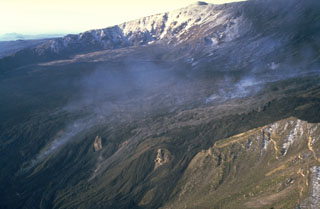 An aerial view looking SW across the Valle del Bove on 6 December 1986 shows a lava flow descending the floor of the broad depression on Etna's E flank. The eruption began on 30 October from a 2-km-long fissure that cut the upper Valle del Bove, and lasted until 27 February 1987. Lava flows traveled 5 km E to 1,325 m altitude.
An aerial view looking SW across the Valle del Bove on 6 December 1986 shows a lava flow descending the floor of the broad depression on Etna's E flank. The eruption began on 30 October from a 2-km-long fissure that cut the upper Valle del Bove, and lasted until 27 February 1987. Lava flows traveled 5 km E to 1,325 m altitude.Photo by Romolo Romano, 1986 (IIV-CNR, Catania, Italy).
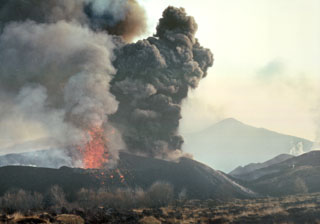 A major eruption took place from fissure vents on the N and S flanks of Italy's Etna volcano beginning on 26 October 2002. Lava flows cut across roads, and several hotels, restaurants, a ski school, ski lift pylons, and power lines were destroyed. This photo, taken on the 28th, looks towards the summit from the lower NE rift zone and shows lava fountaining and an ash plume from the two upper vents as well as small white plumes from the upper part of the eruptive fissure (far middle right).
A major eruption took place from fissure vents on the N and S flanks of Italy's Etna volcano beginning on 26 October 2002. Lava flows cut across roads, and several hotels, restaurants, a ski school, ski lift pylons, and power lines were destroyed. This photo, taken on the 28th, looks towards the summit from the lower NE rift zone and shows lava fountaining and an ash plume from the two upper vents as well as small white plumes from the upper part of the eruptive fissure (far middle right).Photo by Jean-Claude Tanguy, 2002 (University of Paris).
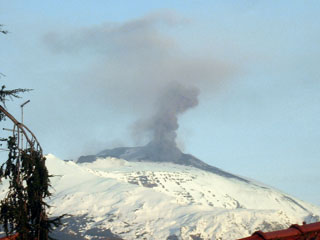 An ash plume rises about 1 km above the active vent on the eastern slope of Etna's Southeast Crater on the morning of 10 January 2008. The view is from Trecastagni, about 16 km SSE of the active vent. Summit vent eruptive activity began with a minor explosive eruption from Bocca Nuova on 19 March 2007. On 29 April activity began at Southeast Crater and flank vents produced lava flows. Intermittent explosive and effusive eruptions from Southeast Crater continued into 2008.
An ash plume rises about 1 km above the active vent on the eastern slope of Etna's Southeast Crater on the morning of 10 January 2008. The view is from Trecastagni, about 16 km SSE of the active vent. Summit vent eruptive activity began with a minor explosive eruption from Bocca Nuova on 19 March 2007. On 29 April activity began at Southeast Crater and flank vents produced lava flows. Intermittent explosive and effusive eruptions from Southeast Crater continued into 2008.Photo courtesy of INGV-Catania, 2007.
 Bubbling mudpots are evidence of continued thermal activity at the Campi Flegrei caldera on the western outskirts of Naples, Italy.
Bubbling mudpots are evidence of continued thermal activity at the Campi Flegrei caldera on the western outskirts of Naples, Italy.Copyrighted photo by Katia and Maurice Krafft, 1971.
 Fossa volcano, at the northern end of the island of Vulcano, has been active throughout the Holocene, and has been the source of most of the historical eruptions of Vulcano. Fossa is a composite volcano that was constructed within the 3-km-wide Caldera della Fossa (whose rim is visible at the upper right), the northernmost of a series of three overlapping calderas on the island. The summit crater of Fossa, seen here from the SE, is 500 m wide and about 100 m deep.
Fossa volcano, at the northern end of the island of Vulcano, has been active throughout the Holocene, and has been the source of most of the historical eruptions of Vulcano. Fossa is a composite volcano that was constructed within the 3-km-wide Caldera della Fossa (whose rim is visible at the upper right), the northernmost of a series of three overlapping calderas on the island. The summit crater of Fossa, seen here from the SE, is 500 m wide and about 100 m deep.Copyrighted photo by Katia and Maurice Krafft, 1982.
 This engraving of the 1631 eruption of Vesuvius shows a vertical eruption column and pyroclastic flows sweeping down the flanks of the volcano to the sea. This is the earliest known depiction of pyroclastic flows. The 1631 eruption was one of the largest at Vesuvius in historical time and began the modern period of frequent, long-duration eruptions.
This engraving of the 1631 eruption of Vesuvius shows a vertical eruption column and pyroclastic flows sweeping down the flanks of the volcano to the sea. This is the earliest known depiction of pyroclastic flows. The 1631 eruption was one of the largest at Vesuvius in historical time and began the modern period of frequent, long-duration eruptions.Engraving by G. Battista Passaro (from the collection of Maurice and Katia Krafft, published in Simkin and Siebert, 1994).
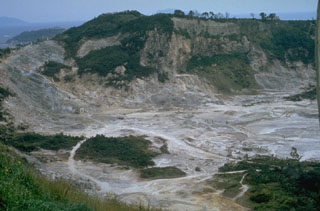 The Solfatara maar-diatreme in the Campi Flegrei caldera was formed during an explosive eruption about 3,850 years ago. The crater is still thermally active, releasing gas that includes H2O, CO2, and CO. A small phreatic eruption occurred at Solfatara in 1198 CE.
The Solfatara maar-diatreme in the Campi Flegrei caldera was formed during an explosive eruption about 3,850 years ago. The crater is still thermally active, releasing gas that includes H2O, CO2, and CO. A small phreatic eruption occurred at Solfatara in 1198 CE.Photo by Roberto Scandone, 1984 (University of Rome).
 The island of Vulcano in Italy's Aeolian Islands is seen here from the volcano observatory on the island of Lipari to the north, with the volcanic peninsula of Vulcanello, initially formed in 183 BCE, in the foreground and Fossa cone in the background. Vulcano consists of at least three volcanic complexes, each of which is truncated by a small caldera. Volcanism has migrated to the north with Fossa cone being the dominant Holocene center. The latest eruption took place from 1888 to 1890.
The island of Vulcano in Italy's Aeolian Islands is seen here from the volcano observatory on the island of Lipari to the north, with the volcanic peninsula of Vulcanello, initially formed in 183 BCE, in the foreground and Fossa cone in the background. Vulcano consists of at least three volcanic complexes, each of which is truncated by a small caldera. Volcanism has migrated to the north with Fossa cone being the dominant Holocene center. The latest eruption took place from 1888 to 1890.Photo by Richard Waitt, 1985 (U.S. Geological Survey).
 Stromboli is shown in this aerial view with the top of the photo facing NW. It has been continuously active for more than 1,300 years and was constructed in two cycles, the last of which formed the western side of the island. A plume trails to the S from the active vent at the head of the Sciara del Fuoco. The scarp was created by a Pleistocene landslide and channels pyroclastic ejecta and lava flows to the west.
Stromboli is shown in this aerial view with the top of the photo facing NW. It has been continuously active for more than 1,300 years and was constructed in two cycles, the last of which formed the western side of the island. A plume trails to the S from the active vent at the head of the Sciara del Fuoco. The scarp was created by a Pleistocene landslide and channels pyroclastic ejecta and lava flows to the west.Photo by the Italian Air Force.
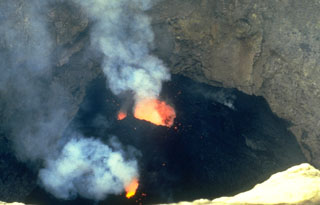 Weak Strombolian activity on 5 December 1985 from Bocca Nuova, one of two active vents in the Central Crater, is typical of persistent summit activity at Etna. Fresh black lava flows cover the floor of the crater. Both Bocca Nuova and the E vent, La Voragine, frequently eject scoria and molten lava bombs that commonly do not reach above the height of the roughly 100-m-high crater. Occasional periods of high lava fountaining and ash ejection also occur.
Weak Strombolian activity on 5 December 1985 from Bocca Nuova, one of two active vents in the Central Crater, is typical of persistent summit activity at Etna. Fresh black lava flows cover the floor of the crater. Both Bocca Nuova and the E vent, La Voragine, frequently eject scoria and molten lava bombs that commonly do not reach above the height of the roughly 100-m-high crater. Occasional periods of high lava fountaining and ash ejection also occur.Photo by Romolo Romano, 1985 (IIV-CNR, Catania, Italy).
 A major explosive eruption in April 1906, one of the largest eruptions of Vesuvius since 1631, destroyed the upper part of the cone. The paroxysmal eruption occurred at the end of a three-decade long, primarily effusive eruption that began in 1875. Periods of more intense eruptions took place in 1881-85, 1891-1900, and 1904.
A major explosive eruption in April 1906, one of the largest eruptions of Vesuvius since 1631, destroyed the upper part of the cone. The paroxysmal eruption occurred at the end of a three-decade long, primarily effusive eruption that began in 1875. Periods of more intense eruptions took place in 1881-85, 1891-1900, and 1904.From the collection of Maurice and Katia Krafft.
 Strombolian eruptions are named after the typical eruptive style of Stromboli volcano, in Italy's Aeolian Islands. Strombolian eruptions are characterized by repetitive moderate explosions that eject fragmental material surrounding the vent along with molten lava bombs. The trajectories of individual incandescent bombs form parabolic arcs in time-lapse photographs.
Strombolian eruptions are named after the typical eruptive style of Stromboli volcano, in Italy's Aeolian Islands. Strombolian eruptions are characterized by repetitive moderate explosions that eject fragmental material surrounding the vent along with molten lava bombs. The trajectories of individual incandescent bombs form parabolic arcs in time-lapse photographs.Copyrighted photo by Katia and Maurice Krafft.
 The Ischia volcanic complex forms a 6 x 9 km island W of the Bay of Naples seen in this International Space Station image. Tectonism has influenced volcanic activity at Ischia, and its high point (the dark-colored area in the center) is a horst (raised fault block) composed of ignimbrite deposits associated with Pleistocene caldera formation. During the Holocene, a series of pumiceous tephras, tuff rings, lava domes, and lava flows were erupted.
The Ischia volcanic complex forms a 6 x 9 km island W of the Bay of Naples seen in this International Space Station image. Tectonism has influenced volcanic activity at Ischia, and its high point (the dark-colored area in the center) is a horst (raised fault block) composed of ignimbrite deposits associated with Pleistocene caldera formation. During the Holocene, a series of pumiceous tephras, tuff rings, lava domes, and lava flows were erupted.NASA International Space Station image ISS002-E-8200, 2001 (http://eol.jsc.nasa.gov/).
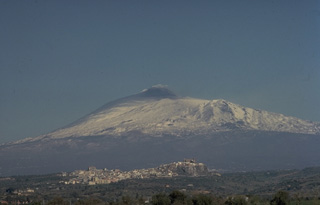 Snow-capped Mount Etna, seen here from the SE, rises more than 3 km above the coastline of Sicily. The massive basaltic stratovolcano is 60 km by 40 km in width. Its summit is truncated by several small calderas, and the Valle de Bove, a 5 x 10 km horseshoe-shaped depression created by incremental landsliding, extends to the eastern coast. Persistent summit eruptive activity is punctuated by intermittent eruptions from cones and fissures that dot its massive flanks.
Snow-capped Mount Etna, seen here from the SE, rises more than 3 km above the coastline of Sicily. The massive basaltic stratovolcano is 60 km by 40 km in width. Its summit is truncated by several small calderas, and the Valle de Bove, a 5 x 10 km horseshoe-shaped depression created by incremental landsliding, extends to the eastern coast. Persistent summit eruptive activity is punctuated by intermittent eruptions from cones and fissures that dot its massive flanks.Copyrighted photo by Katia and Maurice Krafft.
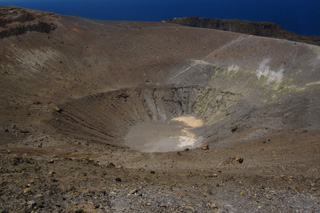 The summit crater of the Vulcano Fossa cone is seen here in May 2011. On the crater wall to the right is discoloration from geothermal activity consisting of fumaroles across a fracture zone. In 2010 the average measured temperature across the field was 190°C.
The summit crater of the Vulcano Fossa cone is seen here in May 2011. On the crater wall to the right is discoloration from geothermal activity consisting of fumaroles across a fracture zone. In 2010 the average measured temperature across the field was 190°C.Photo by Arianna Soldati, 2011.
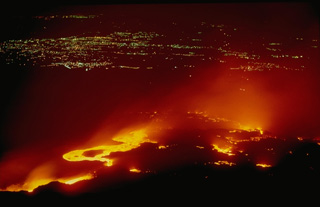 Incandescent lava flows in May 1983 descend the south flank of Mount Etna toward city lights. During the four-month-long eruption, lava descended to 1080 m altitude, stopping just short of inhabited areas. Extensive efforts were made to construct barriers to divert lavas away from populated areas.
Incandescent lava flows in May 1983 descend the south flank of Mount Etna toward city lights. During the four-month-long eruption, lava descended to 1080 m altitude, stopping just short of inhabited areas. Extensive efforts were made to construct barriers to divert lavas away from populated areas. Copyrighted photo by Katia and Maurice Krafft.
 An ash plume rises above the summit of Vesuvius in 1944, near the end of a long-duration eruption that began in 1913. The 1944 eruption produced voluminous lava flows and vigorous explosions that excavated a 300-m-deep crater at the summit. The paroxysmal phase began on 18 March 1944 and ended on 4 April.
An ash plume rises above the summit of Vesuvius in 1944, near the end of a long-duration eruption that began in 1913. The 1944 eruption produced voluminous lava flows and vigorous explosions that excavated a 300-m-deep crater at the summit. The paroxysmal phase began on 18 March 1944 and ended on 4 April.Photo by U.S. Navy, 1944.
 This 31 December 1991 view of Etna from the E shows lava flows descending the headwall of the Valle del Bove. This eruption began from the Southeast Crater and nearby fissures and lasted until 30 March 1993. The eruption was Etna's largest during the past 300 years, producing 0.3 km3 of lava that descended 7.5 km down the flank.
This 31 December 1991 view of Etna from the E shows lava flows descending the headwall of the Valle del Bove. This eruption began from the Southeast Crater and nearby fissures and lasted until 30 March 1993. The eruption was Etna's largest during the past 300 years, producing 0.3 km3 of lava that descended 7.5 km down the flank.Photo by Jean-Claude Tanguy, 1991 (University of Paris).
 The Ischia volcanic complex forms a 6 x 9 km island in the Bay of Naples and is part of the Phlegraean Volcanic District. It is shown in this September 2019 Planet Labs satellite image monthly mosaic (N is at the top). The vegetated area is a resurgent block and the high point of the island. An arcuate collapse scarp in near the center on the island, opening towards the south.
The Ischia volcanic complex forms a 6 x 9 km island in the Bay of Naples and is part of the Phlegraean Volcanic District. It is shown in this September 2019 Planet Labs satellite image monthly mosaic (N is at the top). The vegetated area is a resurgent block and the high point of the island. An arcuate collapse scarp in near the center on the island, opening towards the south.Satellite image courtesy of Planet Labs Inc., 2019 (https://www.planet.com/).
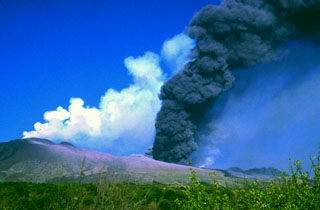 The southern vents of Etna viewed from the SW in the early afternoon of 28 October 2002. From left to right the image shows the summit craters emitting white gas plumes, the cone of Mt. Frumento Supino, vents giving off a dark ash plume, the lower lava vent emitting a faint white plume, new lava flows (dark narrow band), the 2001 cone, and Montagnola cone. Explosive activity began on 26 October and lasted until 28 January 2003. Lava flows cut across roads on the volcano's flanks, causing substantial damage.
The southern vents of Etna viewed from the SW in the early afternoon of 28 October 2002. From left to right the image shows the summit craters emitting white gas plumes, the cone of Mt. Frumento Supino, vents giving off a dark ash plume, the lower lava vent emitting a faint white plume, new lava flows (dark narrow band), the 2001 cone, and Montagnola cone. Explosive activity began on 26 October and lasted until 28 January 2003. Lava flows cut across roads on the volcano's flanks, causing substantial damage.Photo by Jean-Claude Tanguy, 2002 (University of Paris).
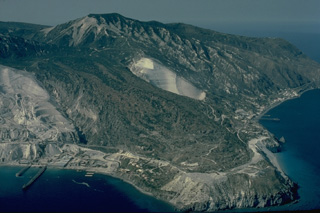 The Rocche Rosse obsidian flow in the foreground forms a peninsula at the NE tip of Lipari Island. It, along with the Forgia Vecchia obsidian flow to the south, was emplaced during the last eruption of Lipari in 729 CE. The lava flows were emplaced following explosive eruptions that ejected large amounts of pumice. The light-colored areas at the center and left are large-scale pumice quarries.
The Rocche Rosse obsidian flow in the foreground forms a peninsula at the NE tip of Lipari Island. It, along with the Forgia Vecchia obsidian flow to the south, was emplaced during the last eruption of Lipari in 729 CE. The lava flows were emplaced following explosive eruptions that ejected large amounts of pumice. The light-colored areas at the center and left are large-scale pumice quarries. Copyrighted photo by Katia and Maurice Krafft.
 Volcanic craters are depressions above a volcanic vent that form as a result of explosive eruptions or collapse. Craters can form at the summit of a volcano or on its flanks. Their sizes and shapes vary widely. Some, like this 600-m wide, 300-m deep crater of Italy's Vesuvius volcano, are large and deep, and have steep-sided walls. Other craters, such as maars and tuff rings produced by powerful explosions involving water-magma interaction, are often much wider than they are deep. Vertical-walled pit craters form by collapse over an eruptive fissure.
Volcanic craters are depressions above a volcanic vent that form as a result of explosive eruptions or collapse. Craters can form at the summit of a volcano or on its flanks. Their sizes and shapes vary widely. Some, like this 600-m wide, 300-m deep crater of Italy's Vesuvius volcano, are large and deep, and have steep-sided walls. Other craters, such as maars and tuff rings produced by powerful explosions involving water-magma interaction, are often much wider than they are deep. Vertical-walled pit craters form by collapse over an eruptive fissure. Copyrighted photo by Katia and Maurice Krafft, 1982.
 The Fossa cone, formed within the Fossa caldera around 6,000 years ago, is seen here in May 2011. Eruptions there have produced lava flows that reach the base of the cone, pyroclastic surge deposits from phreatomagmatic eruptions, ashfall units, and ballistic ejecta.
The Fossa cone, formed within the Fossa caldera around 6,000 years ago, is seen here in May 2011. Eruptions there have produced lava flows that reach the base of the cone, pyroclastic surge deposits from phreatomagmatic eruptions, ashfall units, and ballistic ejecta.Photo by Arianna Soldati, 2011.
 A powerful eruption column rises above the summit of Vesuvius in this painting of the June 1794 eruption, viewed from Naples. This eruption was the most powerful at Vesuvius since 1631. Several towns were completely destroyed, and 400 people were killed. After the eruption the height of Vesuvius was lowered by 121 m, leaving a 2.2-km wide and 150 m deep crater. The 1794 eruption occurred at the end of an eruptive period that began in 1783 and included paroxysmal effussive phases in 1785-1787 and 1790.
A powerful eruption column rises above the summit of Vesuvius in this painting of the June 1794 eruption, viewed from Naples. This eruption was the most powerful at Vesuvius since 1631. Several towns were completely destroyed, and 400 people were killed. After the eruption the height of Vesuvius was lowered by 121 m, leaving a 2.2-km wide and 150 m deep crater. The 1794 eruption occurred at the end of an eruptive period that began in 1783 and included paroxysmal effussive phases in 1785-1787 and 1790.From the collection of Maurice and Katia Krafft.
 Vulcanian eruptions derive their name from the typical eruptive style of Vulcano, in Italy's Aeolian Islands. Vulcanian eruptions consist of phreatomagmatic explosions, which eject dark, ash-laden, cauliflower-shaped eruption columns. After the vent is cleared by the explosions, lava flows may issue from the crater or fissures on its flank. This photo, looking to the south, shows a vulcanian eruption in 1888 from Fossa cone on the island of Vulcano.
Vulcanian eruptions derive their name from the typical eruptive style of Vulcano, in Italy's Aeolian Islands. Vulcanian eruptions consist of phreatomagmatic explosions, which eject dark, ash-laden, cauliflower-shaped eruption columns. After the vent is cleared by the explosions, lava flows may issue from the crater or fissures on its flank. This photo, looking to the south, shows a vulcanian eruption in 1888 from Fossa cone on the island of Vulcano.From the collection of Maurice and Katia Krafft.
 The famous pillars of the Roman temple of Seraphis, in Pozzuoli, have served as unintended markers of periodic uplift of the Campi Flegrei caldera floor. Borings in the marble columns by marine organisms show that the location had sunk 11 m below sea level by 1000 CE and then rose 12 m by 1538, including rapid uplift of 4 m immediately prior to the 1538 eruption of Monte Nuovo. More recent periods of rapid uplift took place in 1970-72 and 1982-84.
The famous pillars of the Roman temple of Seraphis, in Pozzuoli, have served as unintended markers of periodic uplift of the Campi Flegrei caldera floor. Borings in the marble columns by marine organisms show that the location had sunk 11 m below sea level by 1000 CE and then rose 12 m by 1538, including rapid uplift of 4 m immediately prior to the 1538 eruption of Monte Nuovo. More recent periods of rapid uplift took place in 1970-72 and 1982-84.Copyrighted photo by Katia and Maurice Krafft, 1988.
 Geologists examine a quarry in a post-caldera cone of the Vulsini volcanic complex. The base of the quarry exposes thick, red-colored scoria deposits produced by Strombolian eruptions that built a scoria cone. These are overlain by bedded, yellowish pyroclastic surge deposits.
Geologists examine a quarry in a post-caldera cone of the Vulsini volcanic complex. The base of the quarry exposes thick, red-colored scoria deposits produced by Strombolian eruptions that built a scoria cone. These are overlain by bedded, yellowish pyroclastic surge deposits.Photo by Richard Waitt, 1985 (U.S. Geological Survey).
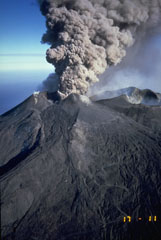 An ash plume rises above Etna’s NE Crater on 24 September 1986. This marked the end of an eruption episode that began in July 1984. Intermittent explosive eruptions from the Northeast Crater took place for two years. In July 1986, Strombolian eruptions formed a scoria cone in the crater. On 14 September 1986 lava overtopped the west rim of Northeast Crater and flowed 1.5 km down its flank.
An ash plume rises above Etna’s NE Crater on 24 September 1986. This marked the end of an eruption episode that began in July 1984. Intermittent explosive eruptions from the Northeast Crater took place for two years. In July 1986, Strombolian eruptions formed a scoria cone in the crater. On 14 September 1986 lava overtopped the west rim of Northeast Crater and flowed 1.5 km down its flank.Photo by Romolo Romano, 1986 (IIV-CNR, Catania, Italy).
 Two days after the onset of the eruption on the morning of 28 October 2002, the southern vents of Etna produce ash and gas plumes. The white plume on the right comes from the lava vent, and the plume in the left background is from the summit craters.
Two days after the onset of the eruption on the morning of 28 October 2002, the southern vents of Etna produce ash and gas plumes. The white plume on the right comes from the lava vent, and the plume in the left background is from the summit craters.Photo by Jean-Claude Tanguy, 2002 (University of Paris).
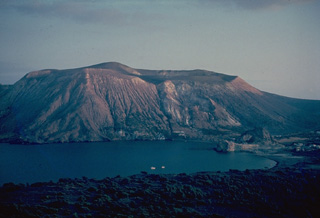 Fossa volcano, seen here from the small cone of Vulcanello to its north, is a 390-m-high tuff cone capped by a 500-m-wide crater. Like tuff rings, tuff cones form as a result of explosive eruptions involving water-magma interaction, but can be less violent, allowing volcanic ejecta to accumulate around the vent, thus forming smaller diameter, steep-sided cones.
Fossa volcano, seen here from the small cone of Vulcanello to its north, is a 390-m-high tuff cone capped by a 500-m-wide crater. Like tuff rings, tuff cones form as a result of explosive eruptions involving water-magma interaction, but can be less violent, allowing volcanic ejecta to accumulate around the vent, thus forming smaller diameter, steep-sided cones.Copyrighted photo by Katia and Maurice Krafft.
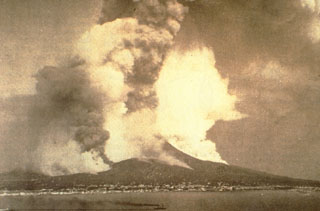 This photograph of Vesuvius looking east across the Bay of Naples depicts the major eruption of April 1872. A vigorous eruption plume rises from the summit crater and ash plumes also rise from a NW flank fissure that fed a lava flow that traveled far down the W flank, overrunning several villages. Steam also rises above another lava flow below and to the right of the summit. This eruption began with lava effusion in December 1870.
This photograph of Vesuvius looking east across the Bay of Naples depicts the major eruption of April 1872. A vigorous eruption plume rises from the summit crater and ash plumes also rise from a NW flank fissure that fed a lava flow that traveled far down the W flank, overrunning several villages. Steam also rises above another lava flow below and to the right of the summit. This eruption began with lava effusion in December 1870.Photo courtesty of Roberto Scandone (University of Rome).
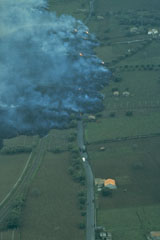 A March 1981 lava flow from vents on the upper NW flank of Mount Etna in Sicily descended 8 km into populated areas and caused extensive damage to orchards and farm buildings. This photo shows the steaming lava flow front as it overran a railroad bed and highway.
A March 1981 lava flow from vents on the upper NW flank of Mount Etna in Sicily descended 8 km into populated areas and caused extensive damage to orchards and farm buildings. This photo shows the steaming lava flow front as it overran a railroad bed and highway.Photo by Romolo Romano, 1981 (IIV-CNR, Catania, Italy).
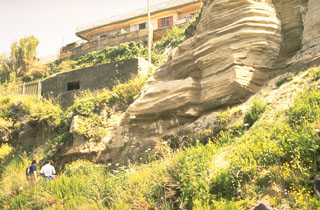 The bedded layers at the right, near the town of Torre de Greco on the S flank of Vesuvius, are pyroclastic surge deposits from the Plinian Avellino eruption that occurred about 3,700 years ago. This eruption, one of eight major explosive eruptions since formation of the Monte Somma caldera, produced 2.9 km3 of tephra. Pyroclastic surges (1 km3) traveled down all sides of the volcano and as far as 22 km NW, covering an area now overlain by much of the city of Naples.
The bedded layers at the right, near the town of Torre de Greco on the S flank of Vesuvius, are pyroclastic surge deposits from the Plinian Avellino eruption that occurred about 3,700 years ago. This eruption, one of eight major explosive eruptions since formation of the Monte Somma caldera, produced 2.9 km3 of tephra. Pyroclastic surges (1 km3) traveled down all sides of the volcano and as far as 22 km NW, covering an area now overlain by much of the city of Naples.Photo by Roberto Scandone (University of Rome).
 Lava flows issued from several vents beginning in May 1858 and lasting until December 1861. The lava flows traveled to the west and SW and caused extensive damage. This eruption began with collapse of the crater of Vesuvius in December 1855.
Lava flows issued from several vents beginning in May 1858 and lasting until December 1861. The lava flows traveled to the west and SW and caused extensive damage. This eruption began with collapse of the crater of Vesuvius in December 1855.From the collection of Maurice and Katia Krafft.
 Villages cling to the only relatively flat area on the island of Stromboli, seen here from the NE. Stromboli, known as the "Lighthouse of the Mediterranean," has been in continuous eruptive activity for at least 1300 years. It is the type locality for "strombolian" eruptions, moderate explosive eruptions that eject ash and incandescent bombs. Steam rises from the active vent at the head of the Sciara del Fuoco near the summit of the 924-m-high volcano.
Villages cling to the only relatively flat area on the island of Stromboli, seen here from the NE. Stromboli, known as the "Lighthouse of the Mediterranean," has been in continuous eruptive activity for at least 1300 years. It is the type locality for "strombolian" eruptions, moderate explosive eruptions that eject ash and incandescent bombs. Steam rises from the active vent at the head of the Sciara del Fuoco near the summit of the 924-m-high volcano. Copyrighted photo by Katia and Maurice Krafft.
 This view of Stromboli shows the NE tip of the island with the Rina Grande valley at the left. The principal historically active vent of Stromboli lies at the head of the Sciarra del Fuoco, a prominent scarp on the opposite side of the island. Stromboli, the NE-most of the Aeolian Islands, has produced frequent mild explosions throughout much of historical time.
This view of Stromboli shows the NE tip of the island with the Rina Grande valley at the left. The principal historically active vent of Stromboli lies at the head of the Sciarra del Fuoco, a prominent scarp on the opposite side of the island. Stromboli, the NE-most of the Aeolian Islands, has produced frequent mild explosions throughout much of historical time.Photo by Guiseppina Kysar, 1999 (Smithsonian Institution).
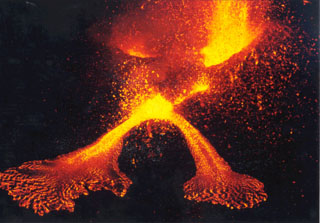 Two vents and lava flows inside Etna’s Voragine crater within the Central Crater are seen in July 1998. Explosions on 17 June and 12 July 1994 were the first sign of explosive activity since the end of the 1991-93 eruption. Intermittent eruptions from the Central Crater, Northeast Crater, and Southeast Crater continued into 2001. Paroxysmal eruptions on 23 December 1995 produced lava fountains as high as 500-600 m, and an eruption column that rose 6.2 km above the summit.
Two vents and lava flows inside Etna’s Voragine crater within the Central Crater are seen in July 1998. Explosions on 17 June and 12 July 1994 were the first sign of explosive activity since the end of the 1991-93 eruption. Intermittent eruptions from the Central Crater, Northeast Crater, and Southeast Crater continued into 2001. Paroxysmal eruptions on 23 December 1995 produced lava fountains as high as 500-600 m, and an eruption column that rose 6.2 km above the summit.Photo by Jean-Claude Tanguy, 1998 (University of Paris).
 The 15-km-long island of Pantelleria is constructed above a drowned continental rift in the Strait of Sicily. Part of the mostly buried arcuate rims of two large Pleistocene calderas are seen in this NASA Landsat image (with N to the top). The SE rims of the calderas form the two dark-colored lines at the lower right part of the island, below and to the right of the forested Monte Grande and Monte Gibele volcanoes. Monte Gibele, with its circular summit crater, was constructed in the southern part of the younger Cinque Denti caldera.
The 15-km-long island of Pantelleria is constructed above a drowned continental rift in the Strait of Sicily. Part of the mostly buried arcuate rims of two large Pleistocene calderas are seen in this NASA Landsat image (with N to the top). The SE rims of the calderas form the two dark-colored lines at the lower right part of the island, below and to the right of the forested Monte Grande and Monte Gibele volcanoes. Monte Gibele, with its circular summit crater, was constructed in the southern part of the younger Cinque Denti caldera.NASA Landsat 7 image (worldwind.arc.nasa.gov)
 The peninsula of Vulcanello (upper left), at the northern end of the island of Vulcano, is the latest of a series of north-migrating eruptive centers on Vulcano. Its growth began in 183 BCE, when submarine eruptions formed an island. Eruptions eventually formed three cones up to 123-m high surrounded by lava flows that joined Vulcanello to the main island. The crater in the foreground is Fossa, the source of most historical eruptions of Vulcano.
The peninsula of Vulcanello (upper left), at the northern end of the island of Vulcano, is the latest of a series of north-migrating eruptive centers on Vulcano. Its growth began in 183 BCE, when submarine eruptions formed an island. Eruptions eventually formed three cones up to 123-m high surrounded by lava flows that joined Vulcanello to the main island. The crater in the foreground is Fossa, the source of most historical eruptions of Vulcano.Copyrighted photo by Katia and Maurice Krafft, 1982.
 This fanciful sketch depicts explosions at Monte Nuovo in 1538, the latest eruption in the Campi Flegrei caldera. The week-long eruption produced a new 100-m-high cinder cone, Monte Nuovo. Small pyroclastic flows during the opening stage of the eruption traveled a few hundred m from the cone. An explosion on the last day of the eruption killed 24 people who had climbed onto the cone.
This fanciful sketch depicts explosions at Monte Nuovo in 1538, the latest eruption in the Campi Flegrei caldera. The week-long eruption produced a new 100-m-high cinder cone, Monte Nuovo. Small pyroclastic flows during the opening stage of the eruption traveled a few hundred m from the cone. An explosion on the last day of the eruption killed 24 people who had climbed onto the cone. From the collection of Maurice and Katia Krafft.
 Stromboli, the "Lighthouse of the Mediterranean," is seen in lurid nighttime eruption in this painting. The slopes of the volcano are unrealistically steep, as is often the case in popular depictions of volcanoes. Stromboli has been in continuous eruption since at least 1300 years.
Stromboli, the "Lighthouse of the Mediterranean," is seen in lurid nighttime eruption in this painting. The slopes of the volcano are unrealistically steep, as is often the case in popular depictions of volcanoes. Stromboli has been in continuous eruption since at least 1300 years.From the collection of Maurice and Katia Krafft.
 Lava flows descending the Valle del Bove on Mount Etna on 16 March 1992, observed from Monte Pomiciaro Belvedere on the S rim. The eruption, which had begun in December 1991, lasted more than 16 months and was the most voluminous at Etna during the past 300 years.
Lava flows descending the Valle del Bove on Mount Etna on 16 March 1992, observed from Monte Pomiciaro Belvedere on the S rim. The eruption, which had begun in December 1991, lasted more than 16 months and was the most voluminous at Etna during the past 300 years.Photo by Jean-Claude Tanguy, 1992 (University of Paris).
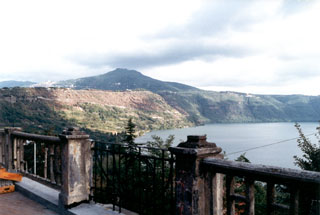 The lake-filled Albano maar is part of the Alban Hills (Monte Albano) complex immediately SE of Rome. The Cavo scoria cone rises beyond the far rim. The Monte Albano complex contains a large Pleistocene stratovolcano with a 10-km-wide caldera. Subsequent eruptions occurred from a 5-km-wide central cone as well as craters and cones within the caldera and on its outer flanks. The youngest known magmatic eruption occurred during the late-Pleistocene.
The lake-filled Albano maar is part of the Alban Hills (Monte Albano) complex immediately SE of Rome. The Cavo scoria cone rises beyond the far rim. The Monte Albano complex contains a large Pleistocene stratovolcano with a 10-km-wide caldera. Subsequent eruptions occurred from a 5-km-wide central cone as well as craters and cones within the caldera and on its outer flanks. The youngest known magmatic eruption occurred during the late-Pleistocene.Photo by Ichio Moriya (Kanazawa University).
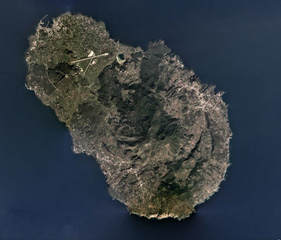 Pantelleria is a volcanic island 95 km west of Sicily and is composed of scoria cones, lava domes, lava flows, explosive eruption deposits, and calderas, with the Cinque Denti caldera rim visible in the right side of this 2019 satellite image (N is to the top). The 330 x 360 m crater near the center is within the summit of Monte Gibele, and lava flows with visible flow levees form the flanks. Montagne Grande is to the west (left) of the crater.
Pantelleria is a volcanic island 95 km west of Sicily and is composed of scoria cones, lava domes, lava flows, explosive eruption deposits, and calderas, with the Cinque Denti caldera rim visible in the right side of this 2019 satellite image (N is to the top). The 330 x 360 m crater near the center is within the summit of Monte Gibele, and lava flows with visible flow levees form the flanks. Montagne Grande is to the west (left) of the crater.Satellite image courtesy of Planet Labs Inc., 2019 (https://www.planet.com/).
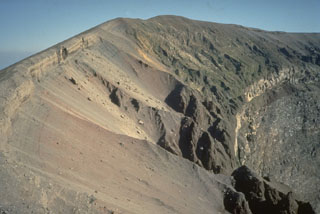 The upper crater rim of Vesuvius is capped by thick tephra deposits from the last eruption episode in 1944. The bedded tephra layers overlie a light-colored layer at the right, a lava flow that had been erupted earlier in the 1944 eruption. The steep wall beneath the 1944 lava flow cuts through pre-1944 lava flows.
The upper crater rim of Vesuvius is capped by thick tephra deposits from the last eruption episode in 1944. The bedded tephra layers overlie a light-colored layer at the right, a lava flow that had been erupted earlier in the 1944 eruption. The steep wall beneath the 1944 lava flow cuts through pre-1944 lava flows.Photo by Roberto Scandone, 1989 (University of Rome).
 During the paroxysmal stage of the 1783-1794 eruption, from June to July 1794, a lava flow from a SW-flank fissure overran the town of Torre de Greco and reached the sea. Ash columns in this painting rise from the summit crater and from the SW flank vent, and steam clouds on the coast mark the point where the lava flow reached the sea.
During the paroxysmal stage of the 1783-1794 eruption, from June to July 1794, a lava flow from a SW-flank fissure overran the town of Torre de Greco and reached the sea. Ash columns in this painting rise from the summit crater and from the SW flank vent, and steam clouds on the coast mark the point where the lava flow reached the sea. From the collection of Maurice and Katia Krafft.
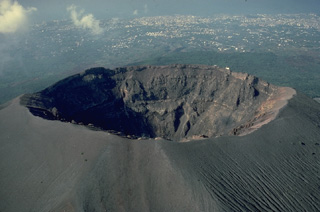 The summit crater of Vesuvius volcano exposes the layered lava flows and ash beds that have constructed the cone. Ash deposits from the 1944 eruption mantle the rim and outer flanks of the 600-m-wide, 300-m-deep crater. The Bay of Naples and numerous cities along the coastal plain that have been affected by historical eruptions of Vesuvius can be seen at the top of the photo, taken from the NE.
The summit crater of Vesuvius volcano exposes the layered lava flows and ash beds that have constructed the cone. Ash deposits from the 1944 eruption mantle the rim and outer flanks of the 600-m-wide, 300-m-deep crater. The Bay of Naples and numerous cities along the coastal plain that have been affected by historical eruptions of Vesuvius can be seen at the top of the photo, taken from the NE.Copyrighted photo by Katia and Maurice Krafft, 1982.
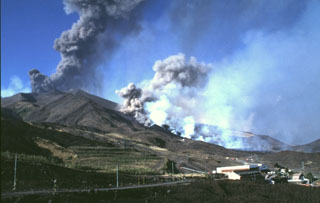 Etna during the climax of the 2001 eruption, which took place on 21-23 July. The upper ash column rises from a vent on the far side of Montagnola. The lower, smaller series of plumes rise from vents and associated lava flow at 2,100 m elevation. The 2001 eruption began on 17 July and lasted until 9 August.
Etna during the climax of the 2001 eruption, which took place on 21-23 July. The upper ash column rises from a vent on the far side of Montagnola. The lower, smaller series of plumes rise from vents and associated lava flow at 2,100 m elevation. The 2001 eruption began on 17 July and lasted until 9 August. Photo by Jean-Claude Tanguy, 2001 (University of Paris).
 Lipari, the largest of Italy's Aeolian Islands, was constructed during four eruptive cycles beginning around 100,000 years ago. Monte Giardina lava dome on the S side of the island, seen here from the NE with Lipari city in the foreground, formed during about 23,000 to 17,000 years ago. Holocene eruptions formed the Pomiciazzo lava dome and the Rocche Rosse and Forgia Vecchia obsidian flows.
Lipari, the largest of Italy's Aeolian Islands, was constructed during four eruptive cycles beginning around 100,000 years ago. Monte Giardina lava dome on the S side of the island, seen here from the NE with Lipari city in the foreground, formed during about 23,000 to 17,000 years ago. Holocene eruptions formed the Pomiciazzo lava dome and the Rocche Rosse and Forgia Vecchia obsidian flows.Photo by Richard Waitt, 1985 (U.S. Geological Survey).
 Panarea Island is the largest subaerial component of a mostly submarine volcanic complex between Lipari and Stromboli volcanoes. The last eruptions took place during the early Holocene, but hydrothermal activity has continued at fumarolic fields at several locations on the submerged platform. The water discoloration in the foreground, 2 km E of Panarea Island, near the small islands took place during November 2002.
Panarea Island is the largest subaerial component of a mostly submarine volcanic complex between Lipari and Stromboli volcanoes. The last eruptions took place during the early Holocene, but hydrothermal activity has continued at fumarolic fields at several locations on the submerged platform. The water discoloration in the foreground, 2 km E of Panarea Island, near the small islands took place during November 2002.Photo courtesy of Istituto Nazionale di Geofisica e Vulcanologia, Sezione di Catania (INGV), 2002.
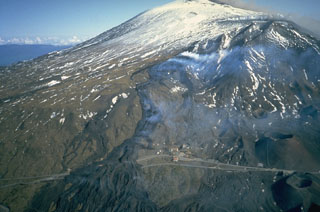 Black lava flows descend the south flank of Etna a week after the eruption began on 28 March 1983 and went on to last for five months. Prominent levees are visible on the surface of the lava flows that crossed a highway and formed a complex lava field as much as 1 km wide. The flows originated from a NNE-SSW-trending fissure 4 km S of Etna's snow-capped Central Crater.
Black lava flows descend the south flank of Etna a week after the eruption began on 28 March 1983 and went on to last for five months. Prominent levees are visible on the surface of the lava flows that crossed a highway and formed a complex lava field as much as 1 km wide. The flows originated from a NNE-SSW-trending fissure 4 km S of Etna's snow-capped Central Crater.Photo by Romolo Romano, 1983 (IIV-CNR, Catania, Italy).
 Etna is Europe's highest volcano, towering above the city of Taormina on its NE flank. One of the world's longest documented historical records continues, dating back to the 2nd millennium BCE. Historical lava flows cover much of the surface of this 40 x 60 km wide basaltic stratovolcano and extend to the sea. Eruptions occur both from persistently active summit craters and intermittently from flank fissures and cones.
Etna is Europe's highest volcano, towering above the city of Taormina on its NE flank. One of the world's longest documented historical records continues, dating back to the 2nd millennium BCE. Historical lava flows cover much of the surface of this 40 x 60 km wide basaltic stratovolcano and extend to the sea. Eruptions occur both from persistently active summit craters and intermittently from flank fissures and cones.Photo by Jean-Claude Tanguy, 1991 (University of Paris).
 This 17th century sketch depicts visitors to Solfatara crater within the Campi Flegrei caldera. Active fumaroles steam along the crater walls. A small phreatic explosion took place at Solfatara in 1198 CE.
This 17th century sketch depicts visitors to Solfatara crater within the Campi Flegrei caldera. Active fumaroles steam along the crater walls. A small phreatic explosion took place at Solfatara in 1198 CE.From the collection of Maurice and Katia Krafft.
 An explosive eruption July 29 to August 13, 1779, produced widespread ashfall that caused extensive damage to many towns. This painting shows a strong eruption column accompanied by lightning as seen from across the Bay of Naples. This eruptive period began in 1770, and included the emission of lava flows in 1770, 1771, 1774, 1776, and 1779.
An explosive eruption July 29 to August 13, 1779, produced widespread ashfall that caused extensive damage to many towns. This painting shows a strong eruption column accompanied by lightning as seen from across the Bay of Naples. This eruptive period began in 1770, and included the emission of lava flows in 1770, 1771, 1774, 1776, and 1779. From the collection of Maurice and Katia Krafft.
 Lava flows in February 1850, during the climactic phase of an eruption that began in 1841, are depicted in this painting overrunning a village on the flanks of Vesuvius. Strombolian eruptions had occurred since 1841. By February 1845, lava filled the entire 1839 crater. The February 1850 lava flows issued from fissures on the flanks of a cone that had grown to about 20 m above the previous crater rim.
Lava flows in February 1850, during the climactic phase of an eruption that began in 1841, are depicted in this painting overrunning a village on the flanks of Vesuvius. Strombolian eruptions had occurred since 1841. By February 1845, lava filled the entire 1839 crater. The February 1850 lava flows issued from fissures on the flanks of a cone that had grown to about 20 m above the previous crater rim.From the collection of Maurice and Katia Krafft.
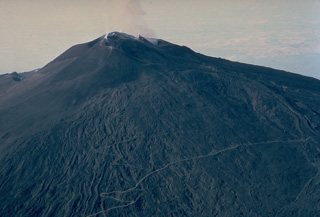 Three large craters cap the summit of Mount Etna, the NE Crater, the Central Crater, and the SE Crater. Long-term minor eruptions occur from the NE and Central craters, and to a lesser extent from the SE Crater, which formed in 1978. Pyroclastic ejecta mantles the upper flanks of the summit cones, and lava flows furrow the lower flanks.
Three large craters cap the summit of Mount Etna, the NE Crater, the Central Crater, and the SE Crater. Long-term minor eruptions occur from the NE and Central craters, and to a lesser extent from the SE Crater, which formed in 1978. Pyroclastic ejecta mantles the upper flanks of the summit cones, and lava flows furrow the lower flanks.Copyrighted photo by Katia and Maurice Krafft.
 This painting of the eruption of Graham Island (Giulia Ferdinandeo) on 13 July 1831 shows late-stage Strombolian eruptions originating from several vents along a fissure. A submarine eruption that began sometime after 28 June eventually constructed a new island that reached a height of 65 m and a diameter of about 500 m. After August, when the eruption ended, the ephemeral island soon eroded beneath the sea.
This painting of the eruption of Graham Island (Giulia Ferdinandeo) on 13 July 1831 shows late-stage Strombolian eruptions originating from several vents along a fissure. A submarine eruption that began sometime after 28 June eventually constructed a new island that reached a height of 65 m and a diameter of about 500 m. After August, when the eruption ended, the ephemeral island soon eroded beneath the sea.From the collection of Maurice and Katia Krafft (published in Simkin and Siebert, 1994).
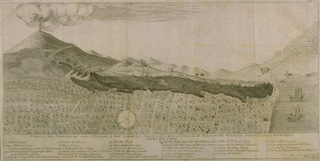 The Torre del Greco lava flow was erupted from December 1760 to January 1761 from a south-flank fissure, 4-km from the sea. Previous paroxysmal eruptions during this eruptive period, which began in 1744, took place in 1751 (from a upper SE flank fissure), and in 1754-55, when lava flows traveled to the south and SE. The 1760-61 paroxysmal stage was accompanied by vigorous explosive eruptions, and marked the first historical eruption of Vesuvius from a vent outside the caldera.
The Torre del Greco lava flow was erupted from December 1760 to January 1761 from a south-flank fissure, 4-km from the sea. Previous paroxysmal eruptions during this eruptive period, which began in 1744, took place in 1751 (from a upper SE flank fissure), and in 1754-55, when lava flows traveled to the south and SE. The 1760-61 paroxysmal stage was accompanied by vigorous explosive eruptions, and marked the first historical eruption of Vesuvius from a vent outside the caldera.From the collection of Maurice and Katia Krafft.
 A lava flow issues from a fissure on the north flank of Vesuvius, in this May 1855 view from the Monte Somma rim. The lava flow ponded in the moat between Vesuvius and Monte Somma before being deflected down the west flank and overrunning the village of San Sabastiano. This eruption began on December 14, 1854.
A lava flow issues from a fissure on the north flank of Vesuvius, in this May 1855 view from the Monte Somma rim. The lava flow ponded in the moat between Vesuvius and Monte Somma before being deflected down the west flank and overrunning the village of San Sabastiano. This eruption began on December 14, 1854. From the collection of Maurice and Katia Krafft.
 Strombolian eruptions in 1834 from cones at the summit of Mount Vesuvius eject incandescent material near the end of an eruption that began in 1824. Major effusive phases occurred from August 1831 to December 1832, and from May to June 1833. The climactic effusive-explosive eruptions took place August 22-September 2, 1834.
Strombolian eruptions in 1834 from cones at the summit of Mount Vesuvius eject incandescent material near the end of an eruption that began in 1824. Major effusive phases occurred from August 1831 to December 1832, and from May to June 1833. The climactic effusive-explosive eruptions took place August 22-September 2, 1834.From the collection of Maurice and Katia Krafft.
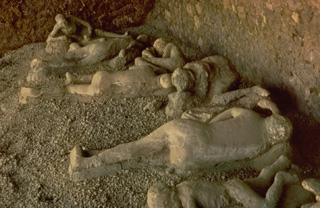 Casts of victim's bodies from the 79 CE eruption of Vesuvius were uncovered during excavations of the buried city of Pompeii. The Pompeii fatalities were caused by pyroclastic flows, which swept as far as 30 km from the summit. Fine-grained ash hardened around the bodies, preserving features in great detail.
Casts of victim's bodies from the 79 CE eruption of Vesuvius were uncovered during excavations of the buried city of Pompeii. The Pompeii fatalities were caused by pyroclastic flows, which swept as far as 30 km from the summit. Fine-grained ash hardened around the bodies, preserving features in great detail.Copyrighted photo by Katia and Maurice Krafft, 1971.
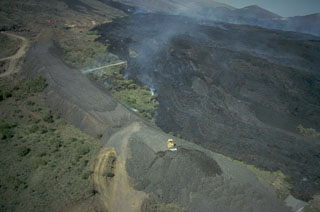 A major S-flank eruption of Etna beginning on 28 March 1983 produced lava flows that damaged tourist facilities. Extensive efforts at lava diversion, such as the gray embankment at the left of this photo, were made to divert the flows from populated areas. The flows eventually descended to 1,080 m altitude and stopped short of several villages.
A major S-flank eruption of Etna beginning on 28 March 1983 produced lava flows that damaged tourist facilities. Extensive efforts at lava diversion, such as the gray embankment at the left of this photo, were made to divert the flows from populated areas. The flows eventually descended to 1,080 m altitude and stopped short of several villages.Photo by Romolo Romano, 1983 (IIV-CNR, Catania, Italy).
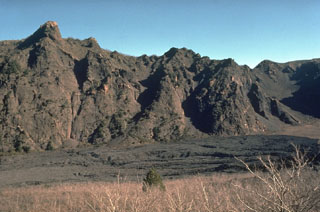 The dark-colored lava flow filling the caldera moat between the cone of Vesuvius and the caldera wall of Monte Somma in the background was produced during an eruption in 1944, near the end of the eruptive cycle that began in 1913.
The dark-colored lava flow filling the caldera moat between the cone of Vesuvius and the caldera wall of Monte Somma in the background was produced during an eruption in 1944, near the end of the eruptive cycle that began in 1913.Photo by Roberto Scandone, 1989 (University of Rome).
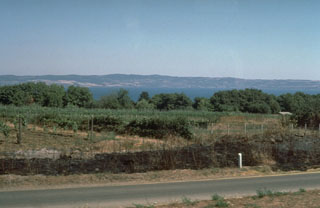 The 16-km-wide Bolsena caldera containing Lago di Bolsena, is the most prominent feature of the Vulsini volcanic complex NW of Rome. The 2,000 km2 volcanic complex also includes the Latera caldera to the west. Both calderas were formed during the Pleistocene. Post-caldera eruptions produced scoria cones, lava flows, and youthful-looking cones that form islands in Lago di Bolsena.
The 16-km-wide Bolsena caldera containing Lago di Bolsena, is the most prominent feature of the Vulsini volcanic complex NW of Rome. The 2,000 km2 volcanic complex also includes the Latera caldera to the west. Both calderas were formed during the Pleistocene. Post-caldera eruptions produced scoria cones, lava flows, and youthful-looking cones that form islands in Lago di Bolsena.Photo by Richard Waitt, 1985 (U.S. Geological Survey).
 The small Amiata lava dome complex (just right of the center of this image), is located about 20 km NW of Lake Bolsena (left-center) in the southern Tuscany region of Italy. The largest of the domes is Monte Amiata (La Vetta). No eruptive activity has occurred during the Holocene, but thermal activity continues at a producing geothermal field.
The small Amiata lava dome complex (just right of the center of this image), is located about 20 km NW of Lake Bolsena (left-center) in the southern Tuscany region of Italy. The largest of the domes is Monte Amiata (La Vetta). No eruptive activity has occurred during the Holocene, but thermal activity continues at a producing geothermal field.NASA International Space Station image ISS008-E-7007, 2003 (http://eol.jsc.nasa.gov/).
 This photomosaic was taken from a helicopter of the Italian Civil Defense Department on 15 May 2008. The eastern sector of Etna has an active eruptive fissure just below the summit craters to the right, and the extent of active lava flows in the Valle del Bove is seen in the center to the left. A major effusive eruption began on 13 May and within the first month lava flows had traveled about 5 km down the Valle del Bove. Effusive activity continued into 2009.
This photomosaic was taken from a helicopter of the Italian Civil Defense Department on 15 May 2008. The eastern sector of Etna has an active eruptive fissure just below the summit craters to the right, and the extent of active lava flows in the Valle del Bove is seen in the center to the left. A major effusive eruption began on 13 May and within the first month lava flows had traveled about 5 km down the Valle del Bove. Effusive activity continued into 2009.Photo courtesy of INGV-Catania, 2008.
 Incandescent explosive eruptions from the summit crater in October 1767 accompany a lava flow from a fissure on the upper north and NW flanks that descends toward Portici, on the west flank. This marked the end of an eruption that began in 1764. In 1766 a lava flow traveled to the WSW, towards Resina, and to the south, towards Torre Annunziata.
Incandescent explosive eruptions from the summit crater in October 1767 accompany a lava flow from a fissure on the upper north and NW flanks that descends toward Portici, on the west flank. This marked the end of an eruption that began in 1764. In 1766 a lava flow traveled to the WSW, towards Resina, and to the south, towards Torre Annunziata.From the collection of Maurice and Katia Krafft.
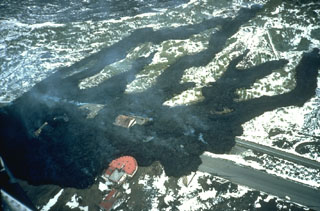 Fresh black lava flows overrun a highway and tourist facility buildings the day after the start of an eruption at Sicily's Mount Etna on 28 March 1983. The lava flows originated from a fissure 4 km S of the summit, and over a 5-month period formed a complex lava field as much as 1 km wide.
Fresh black lava flows overrun a highway and tourist facility buildings the day after the start of an eruption at Sicily's Mount Etna on 28 March 1983. The lava flows originated from a fissure 4 km S of the summit, and over a 5-month period formed a complex lava field as much as 1 km wide.Photo by Romolo Romano, 1983 (IIV-CNR, Catania, Italy).
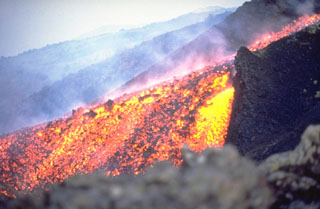 An active lava channel near the vent of the March 1981 NW flank eruption fed flows that traveled 7.5 km. The week-long eruption, one of few Etna eruptions originating on the NW or NNW flanks, entered populated areas and resulted in evacuations. Active vents progressively migrated downhill along eruptive fissures between 2,250 and 1,150 m altitude and produced vigorous lava fountains and lava flows.
An active lava channel near the vent of the March 1981 NW flank eruption fed flows that traveled 7.5 km. The week-long eruption, one of few Etna eruptions originating on the NW or NNW flanks, entered populated areas and resulted in evacuations. Active vents progressively migrated downhill along eruptive fissures between 2,250 and 1,150 m altitude and produced vigorous lava fountains and lava flows.Photo by Roberto Scandone (University of Rome).
 An eruption at Etna on 30 October 2002 shows incandescent lava fountains and associated spatter. The photo was taken from Mt. Ponte di Ferro looking E. This was part of an eruption that began on 26 October. Lava fountaining began on 27 October from fissure vents on the N and S flanks.
An eruption at Etna on 30 October 2002 shows incandescent lava fountains and associated spatter. The photo was taken from Mt. Ponte di Ferro looking E. This was part of an eruption that began on 26 October. Lava fountaining began on 27 October from fissure vents on the N and S flanks.Photo by Jean-Claude Tanguy, 2002 (University of Paris).
 The active vents of Stromboli volcano consist of a series of small craters and cones at the head of the Sciara del Fuoco, a landslide scarp that extends to the NW coast of the island. The location and size of individual craters changes frequently during the course of Stromboli's long-duration eruption.
The active vents of Stromboli volcano consist of a series of small craters and cones at the head of the Sciara del Fuoco, a landslide scarp that extends to the NW coast of the island. The location and size of individual craters changes frequently during the course of Stromboli's long-duration eruption.Copyrighted photo by Katia and Maurice Krafft.
 Lava flows spread over the snow-covered slopes of Etna on 17 March 1981 at the beginning of a NW-flank eruption. During the six-day eruption lava flows descended 8 km into populated areas and caused significant damage.
Lava flows spread over the snow-covered slopes of Etna on 17 March 1981 at the beginning of a NW-flank eruption. During the six-day eruption lava flows descended 8 km into populated areas and caused significant damage.Photo by Romolo Romano, 1981 (IIV-CNR, Catania, Italy).
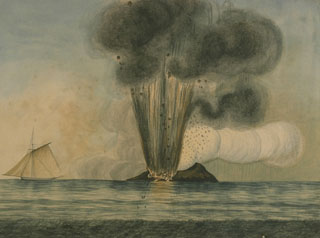 An eruption at Graham Island (Giulia Ferdinandeo) in the Sicilian Sea in 1831. A new island was formed that was promptly claimed by Italy, France, Britain, and Spain. The island quickly eroded to beneath the sea surface after the eruption ended. Graham Island (also known as Ferdinandeo Bank) is part of the Campi Flegrei del Mar di Sicilia (Phlegraean Fields of the Sicily Sea), a group of submarine volcanoes constructed within a depression about 1,000 m deep, SW of Sicily.
An eruption at Graham Island (Giulia Ferdinandeo) in the Sicilian Sea in 1831. A new island was formed that was promptly claimed by Italy, France, Britain, and Spain. The island quickly eroded to beneath the sea surface after the eruption ended. Graham Island (also known as Ferdinandeo Bank) is part of the Campi Flegrei del Mar di Sicilia (Phlegraean Fields of the Sicily Sea), a group of submarine volcanoes constructed within a depression about 1,000 m deep, SW of Sicily.From the collection of Maurice and Katia Krafft (published in Simkin and Siebert, 1994).
 A powerful ash column in October 1822 rises above the crater of Vesuvius in this painting from a location across the Bay of Naples. A major explosive and effusive eruption during October-November 1822 marked the end of a long eruptive period that began in 1796. Major effusive and explosive phases in 1804, 1805, and 1806 included a 1806 lava flow that reached the sea just south of Torre de Greco, on the SW flank.
A powerful ash column in October 1822 rises above the crater of Vesuvius in this painting from a location across the Bay of Naples. A major explosive and effusive eruption during October-November 1822 marked the end of a long eruptive period that began in 1796. Major effusive and explosive phases in 1804, 1805, and 1806 included a 1806 lava flow that reached the sea just south of Torre de Greco, on the SW flank.From the collection of Maurice and Katia Krafft.
 Campi Flegrei del Mar di Sicilia (Phlegraean Fields of the Sicily Sea) is a group of submarine volcanoes off the coast of Sicily. Submarine banks rise from a 1000-m-deep depression between Sicily and Tunisia to near sea level. Submarine eruptions have been recorded since the 3rd century BCE, including some that built ephemeral islands, such as this one at Graham Island (Giulia Ferdinandeo), in 1831.
Campi Flegrei del Mar di Sicilia (Phlegraean Fields of the Sicily Sea) is a group of submarine volcanoes off the coast of Sicily. Submarine banks rise from a 1000-m-deep depression between Sicily and Tunisia to near sea level. Submarine eruptions have been recorded since the 3rd century BCE, including some that built ephemeral islands, such as this one at Graham Island (Giulia Ferdinandeo), in 1831. From the collection of Maurice and Katia Krafft.
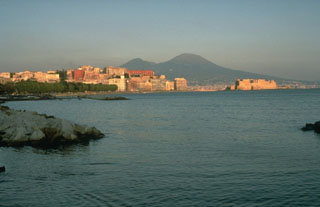 Mount Vesuvius behind city of Naples. The modern cone of Vesuvius is flanked on the left by Monte Somma, the rim of a caldera that formed about 17,000 years ago. Eight major explosive eruptions have occurred since, including the 79 CE eruption that destroyed Pompeii and other towns. A period of frequent, long-duration eruptions began in 1631 and the latest eruption of Vesuvius was in 1944.
Mount Vesuvius behind city of Naples. The modern cone of Vesuvius is flanked on the left by Monte Somma, the rim of a caldera that formed about 17,000 years ago. Eight major explosive eruptions have occurred since, including the 79 CE eruption that destroyed Pompeii and other towns. A period of frequent, long-duration eruptions began in 1631 and the latest eruption of Vesuvius was in 1944.Photo by Dan Dzurisin, 1983 (U.S. Geological Survey).
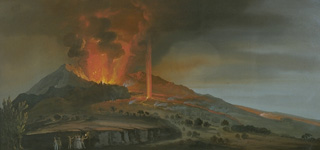 A painting depicts an eruption of Mount Etna on August 21, 1852. The eruption, which began the previous day, originated from a radial fissure in the Valle del Bove, the large horseshoe-shaped depression on the east flank. Explosive eruptions occurred along the fissure, which fed lava flows down the west flank that damaged inhabited areas.
A painting depicts an eruption of Mount Etna on August 21, 1852. The eruption, which began the previous day, originated from a radial fissure in the Valle del Bove, the large horseshoe-shaped depression on the east flank. Explosive eruptions occurred along the fissure, which fed lava flows down the west flank that damaged inhabited areas.From the collection of Maurice and Katia Krafft.
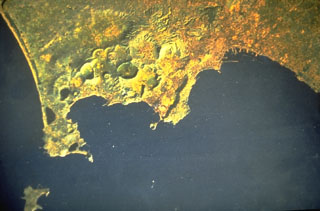 A Landsat satellite image shows the Campi Flegrei caldera north of the Bay of Naples. The 13-km-wide caldera, immediately west of the city of Naples (upper right), was created following massive explosive eruptions about 34,000 and 12,000 years ago. Subsequent eruptions formed numerous craters and cones within the caldera and along its margins. The most recent eruption created the Monte Nuovo tuff cone in 1538.
A Landsat satellite image shows the Campi Flegrei caldera north of the Bay of Naples. The 13-km-wide caldera, immediately west of the city of Naples (upper right), was created following massive explosive eruptions about 34,000 and 12,000 years ago. Subsequent eruptions formed numerous craters and cones within the caldera and along its margins. The most recent eruption created the Monte Nuovo tuff cone in 1538.NASA Landsat image, 1984.
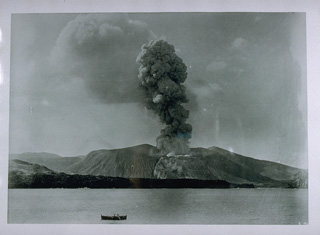 An eruption plume rises above Fossa cone on Vulcano in 1888 in this photo taken from a position offshore to the NE during the last historical eruption of the volcano. The eruption began on August 2, and persistant explosive activity, occasionally accompanied by minor pyroclastic surges, continued until March 22, 1890.
An eruption plume rises above Fossa cone on Vulcano in 1888 in this photo taken from a position offshore to the NE during the last historical eruption of the volcano. The eruption began on August 2, and persistant explosive activity, occasionally accompanied by minor pyroclastic surges, continued until March 22, 1890.From the collection of Maurice and Katia Krafft.
 Vesuvius rises above an excavated stadium in the buried city of Pompeii. The 79 CE eruption began on 24 August with phreatomagmatic explosions that produced widespread ashfall. Many residents of Pompei and other towns had evacuated prior to the onset of devastating pyroclastic flows the following day that swept over broad areas as far as 30 km from the volcano and caused several thousand fatalities.
Vesuvius rises above an excavated stadium in the buried city of Pompeii. The 79 CE eruption began on 24 August with phreatomagmatic explosions that produced widespread ashfall. Many residents of Pompei and other towns had evacuated prior to the onset of devastating pyroclastic flows the following day that swept over broad areas as far as 30 km from the volcano and caused several thousand fatalities.Photo by Dan Dzurisin (U.S. Geological Survey), 1983.
 Three large calderas are seen in this NASA International Space Station image (with north to the upper left) of the Vulsini volcanic complex in central Italy. The 16-km-wide Lake Bolsena (left-center) was formed during major Pleistocene explosive eruptions at about 300,000 years ago and the 8 x 11 km wide Latera caldera (below and to the left of Bolsena) about 160,000 years ago. Post-caldera volcanism produced scoria cones and lava flows (lower left) until recent times. Pleistocene Lake Vico in the Cimini Mountains lies at the right-center.
Three large calderas are seen in this NASA International Space Station image (with north to the upper left) of the Vulsini volcanic complex in central Italy. The 16-km-wide Lake Bolsena (left-center) was formed during major Pleistocene explosive eruptions at about 300,000 years ago and the 8 x 11 km wide Latera caldera (below and to the left of Bolsena) about 160,000 years ago. Post-caldera volcanism produced scoria cones and lava flows (lower left) until recent times. Pleistocene Lake Vico in the Cimini Mountains lies at the right-center.NASA International Space Station image ISS006-E-36701, 2003 (http://eol.jsc.nasa.gov/).
 Monte Amiata seen from near Radicofani, E of the volcano. The late-Pleistocene lava dome complex is located about 20 km NW of Lake Bolsena in the southern Tuscany region of Italy. The complex formed during two major eruptive episodes about 300,000 and 200,000 years ago. No eruptive activity has occurred during the Holocene, but thermal activity resulting in cinnabar mineralization continues at a producing geothermal field near the town of Bagnore.
Monte Amiata seen from near Radicofani, E of the volcano. The late-Pleistocene lava dome complex is located about 20 km NW of Lake Bolsena in the southern Tuscany region of Italy. The complex formed during two major eruptive episodes about 300,000 and 200,000 years ago. No eruptive activity has occurred during the Holocene, but thermal activity resulting in cinnabar mineralization continues at a producing geothermal field near the town of Bagnore.Photo by Anita Cadoux, 2002 (Instituto de Geofísica, UNAM, Mexico).
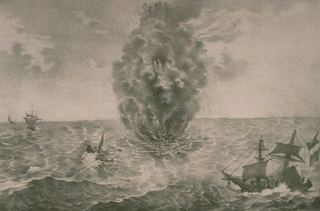 A column of steam and ash rises above the sea surface during the early phase of a submarine eruption in 1831 at Graham Island (Giulia Ferdinandeo) south of Sicily. Earthquakes were first reported on June 28. During the first few days, floating matter, boiling water, and dead fish were observed. On July 8 black smoke was ejected, and by the 12th pumice washed up on the shores of Sicily. A new, but short-lived island was first seen on July 16.
A column of steam and ash rises above the sea surface during the early phase of a submarine eruption in 1831 at Graham Island (Giulia Ferdinandeo) south of Sicily. Earthquakes were first reported on June 28. During the first few days, floating matter, boiling water, and dead fish were observed. On July 8 black smoke was ejected, and by the 12th pumice washed up on the shores of Sicily. A new, but short-lived island was first seen on July 16.From the collection of Maurice and Katia Krafft.
This is a compilation of Italy volcano information sources, such as official monitoring or other government agencies.
| Civil Protection Agencies | |
|---|---|
| Dipartimento della Protezione Civile - Italy Volcanoes | |
| - Dipartimento della Protezione Civile - Italy Volcano Alert Levels | |
| Volcanic Ash Advisory Center | |
|---|---|
| Toulouse Volcanic Ash Advisory Center (VAAC) Notices and Archive | |


